Gamification Metrics and KPIs
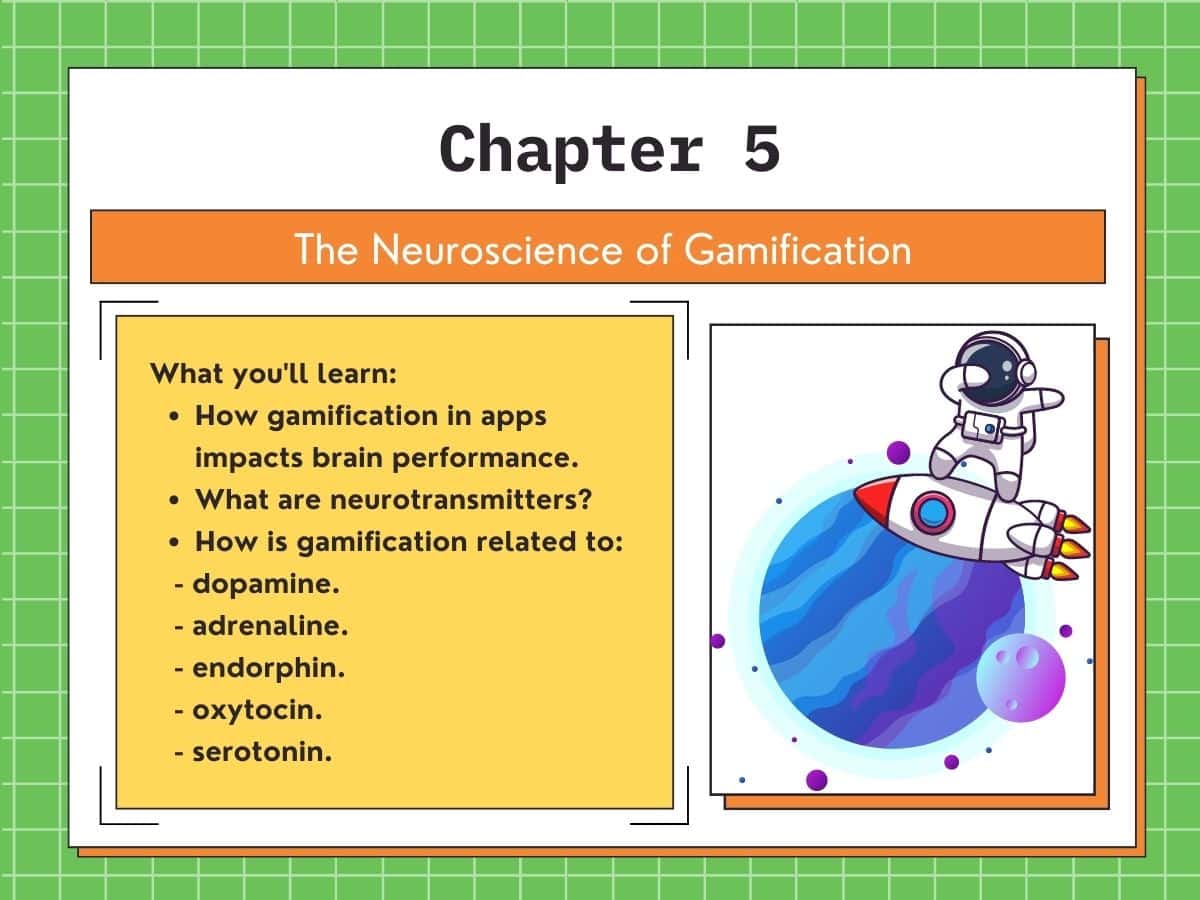
What KPIs and metrics exactly can be gamified? The answer might surprise you: a lot more than you might think. From app engagement to sales to employee performance and even healthcare metrics, the applications for gamification are vast and versatile. Understanding what metrics and KPIs can be gamified is your first step towards a more engaging product or service.
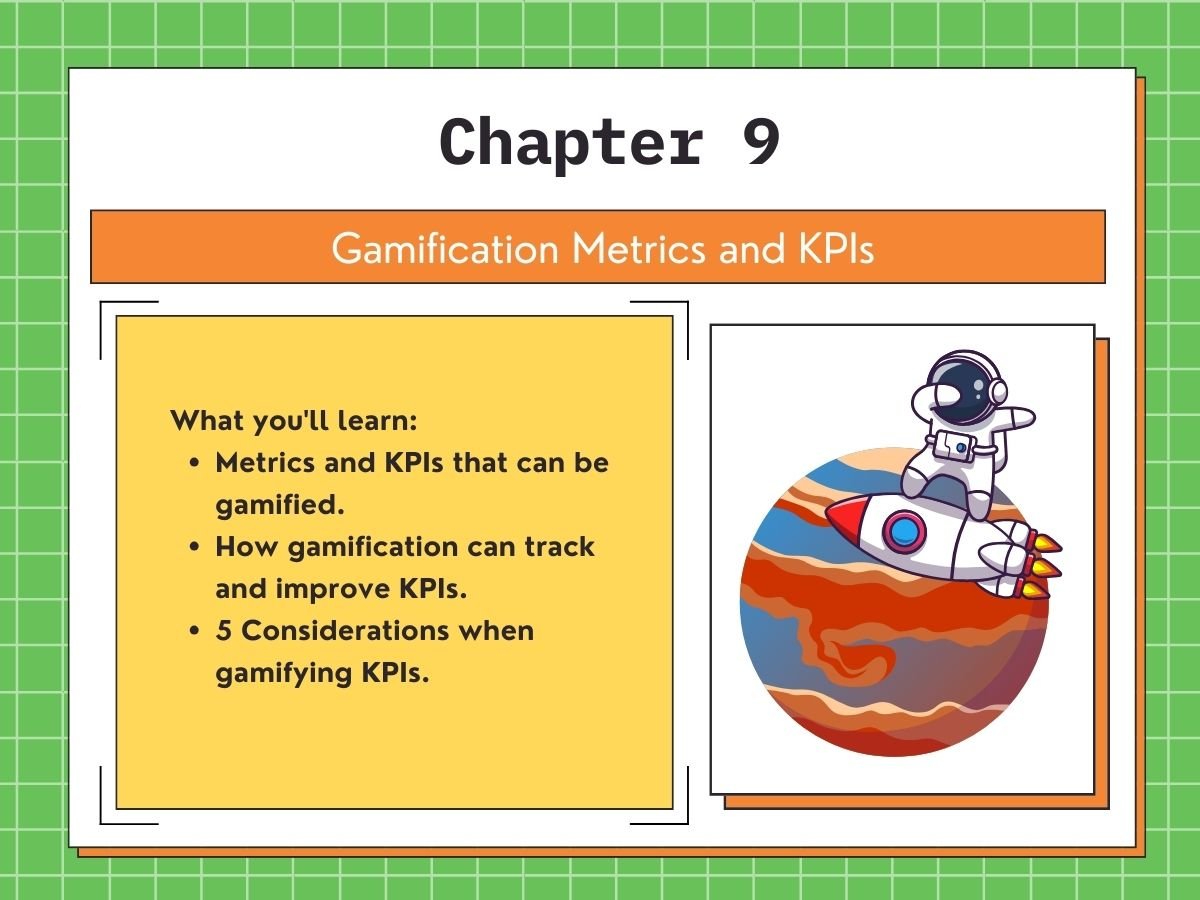
Chapters
- Financial management metrics
- App engagement metrics
Sales metrics - Contact centre metrics
- E-learning metrics
- Software development metrics
- Marketing metrics
- Social media engagement metrics
- Website metrics
- Healthcare and wellness metrics
- Fitness and wellness metrics
- Productivity and time management metrics
- Employee performance metrics
- Community engagement metrics
You are in Chapter 9 of the Beginner’s Gamification Guide.
We know you’ve been itching to know what business metrics benefit from gamification. So, here’s the good news: you’ve finally arrived at the right chapter.
This chapter’ll explore which metrics can be gamified and how to do it effectively. You’ll learn actionable strategies such as boosting engagement through activity streams, measuring and rewarding progress, and personalising user experience. The guide wraps up five key considerations to maximise your ROI from your gamification efforts.
Let’s dive right in and identify what metrics you can use to make your business more engaging and impactful!
What metrics and KPIs can be gamified?
Gamification is a versatile toolkit for enhancing business performance across different industries. Because of its flexibility, many businesses use it for various applications to benefit their organisations.
Once you understand which KPIs are ripe for gamification, you can boost engagement, productivity, and other aspects of your business.
The list of KPIs we have below is quite extensive. However, we’ll highlight some commonly gamified ones to shed light on their practical applications for each sector. Let’s take a look at some of the sectors that leverage the power of KPI gamification.
Implementing game mechanics can significantly enhance your financial management efforts.
Many big names in the finance industry, such as Robinhood, have used this strategy to make trading more fun and exciting. Whether you’re catering to users who want to save or invest, there are plenty of ways that gamification can help you out.
Let’s examine the financial management gamification metrics and KPIs listed below. They will give you a clearer understanding of the capabilities of gamification and what metrics you should optimise.
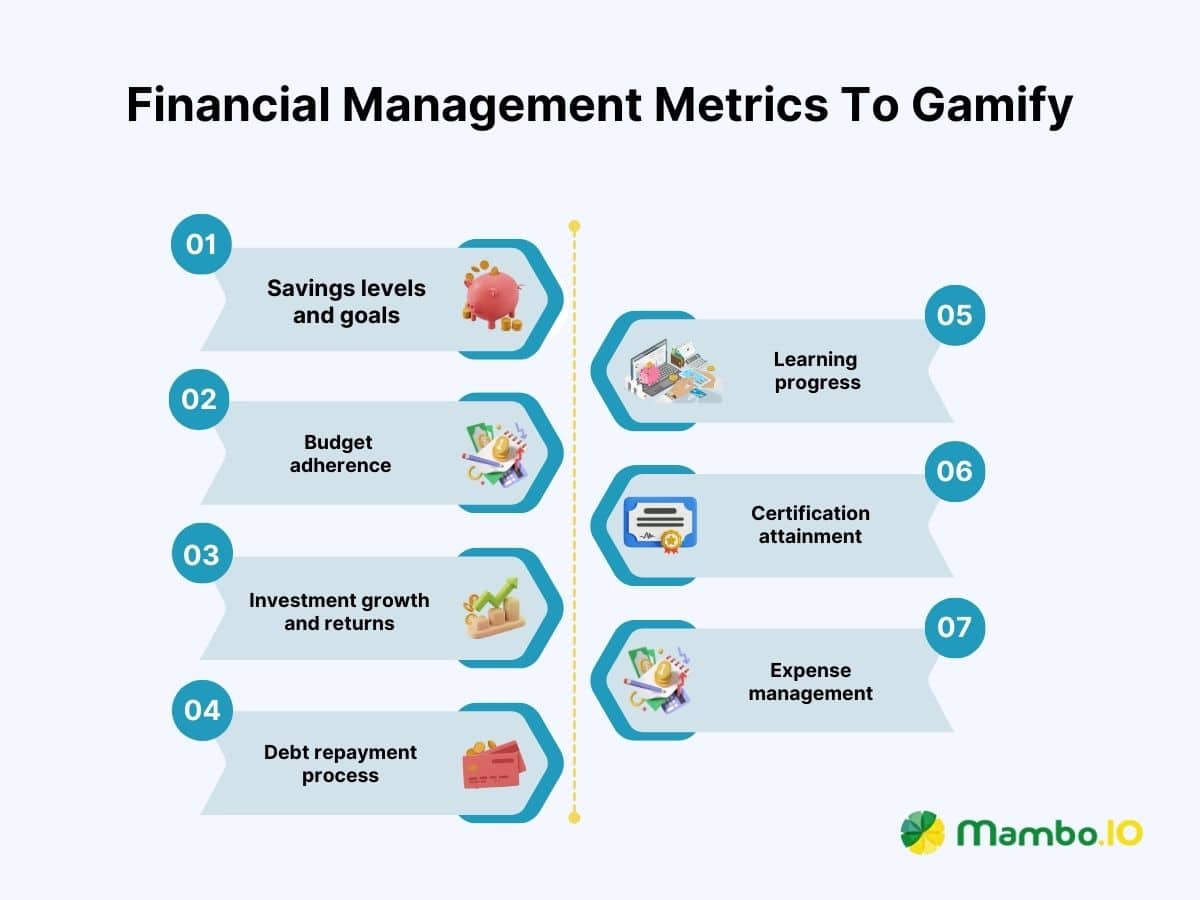
Savings levels and goals
The savings level represents the amount of money customers spend while saving goals are their targets. Gamifying these metrics involves turning saving money into challenges. The key here is to create a sense of accomplishment when customers reach their goals.
Budget adherence
Budget adherence measures how well customers stick to their budget plans. To gamify this, set up a point system to encourage them to stay within budget limits. Offer rewards like discounts or access to exclusive content to those who maintain high adherence levels.
Investment growth and returns
Investment growth measures how well your investments perform, and returns represent the gains (or losses). Gamifying these metrics will make investments more engaging because users earn points or reach new levels as investments grow. Consider time-based rewards for long-term investors to keep them engaged.
Debt repayment process
The debt repayment process measures how effectively you reduce your debts. It’s a critical aspect of financial management, and gamifying it can be surprisingly effective.
Try rewarding users as they reduce their debt and celebrate milestones like paying off a credit card or a loan. Additionally, consider offering advice or resources to help users tackle their debts more effectively.
Learning progress
Learning progress measures how well employees are absorbing financial training material. Some things you can do to gamify this metric include creating interactive quizzes or challenges related to financial topics. You should also use a score-based system and reward employees as they advance.
Certification attainment
Encourage employees to earn financial certifications by making learning enjoyable. Recognise employees who complete financial training programs and provide tangible benefits such as bonuses.
Expense management
Gamify expense management by rewarding employees for cost-saving ideas and adherence to company expense policies. You can set up a system that tracks cost reductions and allocates points or incentives to encourage responsible spending.
User engagement can make or break your app. 1 out of 4 users abandon their apps after using them once. So, it’s up to developers to make sure their solutions are designed to be engaging to users.
There’s a plethora of app engagement metrics out there. And while it’s tempting to gamify everything, it’s essential to be strategic in choosing where to pour your efforts. Let’s explore some of the most common app engagement gamification metrics and KPIs you can use.
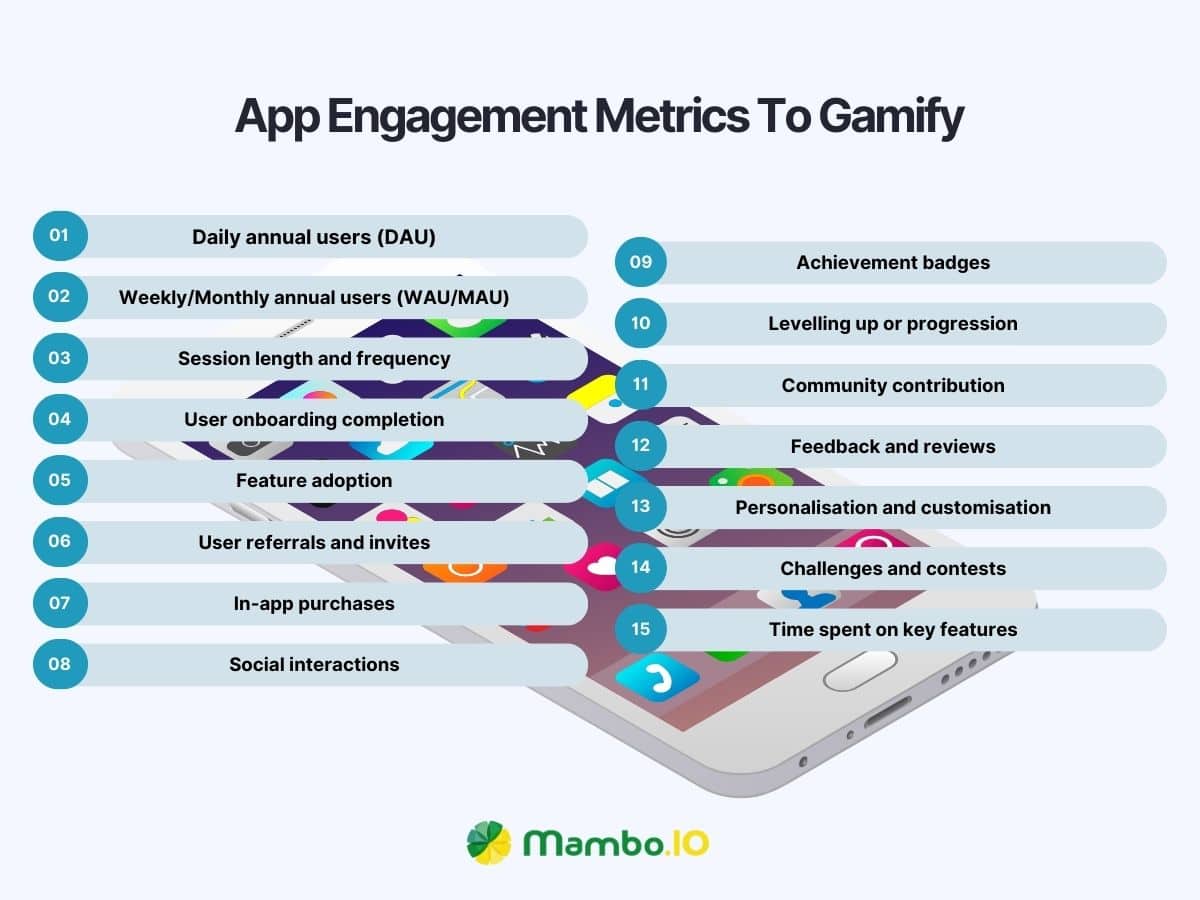
Daily active users (DAU)
Daily active users (DAU) represent the number of unique users interacting with your app daily. To gamify this, you can implement daily challenges or rewards to encourage users to open your app daily. You can use streaks or leaderboards to create competition and maintain consistent engagement.
Weekly/Monthly active users (WAU/MAU)
Weekly active users (WAU) and monthly active users (MAU) measure the number of users engaging with your app weekly and monthly. You can implement these by offering special bonuses, exclusive content, or discounts to consistently returning users. The goal is to extend the user’s journey by rewarding their loyalty.
Session length and frequency
Session length indicates the time users spend in a single app session. As for the frequency, the metric tracks how often they open your app. To gamify these metrics, you can introduce time-based challenges to grant rewards for longer sessions. Send notifications or reminders to entice users into your app to keep them engaged and returning for more.
User onboarding completion
This metric reflects the percentage of users who complete the onboarding process. You can incorporate a step-by-step gamified tutorial if you want to implement this. Users can earn points or badges as they complete each onboarding step to make the process interactive and enjoyable.
Feature adoption
Feature adoption measures how often users engage with new features in your app. Use tutorials, tooltips, or challenges to guide users through new features. More importantly, award them when they explore and actively use these features.
User referrals and invites
This metric gauges how many users are referring others to your app. Encourage users to refer friends with incentives like discounts, extra features, or in-app currency. Doing so will create a sense of community by allowing them to track their referrals.
In-app purchases (IAP)
This metric tracks the revenue generated from purchases done within your app. One effective way to gamify this is by rewarding users with virtual currency for purchases. Then, let them spend it on in-app items or upgrades.
Social interactions
Social interactions measure user interactions such as comments, likes, or messages. To gamify these metrics, you can create social engagement challenges like posting content, tagging friends, or participating in discussions. The goal here is to encourage users to connect and engage more with each other.
Achievement badges
Achievement badges are visual rewards given to users for specific accomplishments. You can gamify your achievement badges by designing them for app-related achievements like reaching a milestone or mastering a skill. Your users can display these badges in their profiles to show their accomplishments.
Levelling up or progression
Levels and progressions reflect the user’s progression while using your app or platform. You can implement a levelling system to gamify this and let your users earn XP for each action. As they accumulate more XP, they level up and unlock new features, challenges, or privileges.
Community contributions
Community contributions measure how users actively contribute to a community, like forums or user-generated content. You can reward active contributors with titles, exclusive access, or recognition within the community. Additionally, you may implement other incentives to motivate them to share their knowledge and experiences.
Feedback and reviews
Feedback and reviews include user feedback, app store ratings, and website reviews. You can implement gamification to encourage users to leave reviews or feedback by offering rewards for their valuable input.
Personalisation and customisation
This metric reflects how much users personalise their app experience. To gamify this metric, you can guide users through personalisation options and offer rewards for setting preferences. Ultimately, your objective should be to make their experiences unique and personal.
Challenges and contests
Challenges and contests are structured events or competitions within your app that encourage user participation. You can create time-bound challenges or contests with exciting prizes. Challenge users to compete and showcase their skills.
Time spent on key features
This metric measures how much time users invest in using the essential features of your app. Gamifying this metric involves rewarding users for spending more time with points or bonuses on critical features. You can also encourage them to explore and maximise these features.
In sales, gamification is a dynamic tool for amplifying performance and driving results. This field is expansive, and each metric offers a unique opportunity for improvement. But to maximise efficiency, you must identify those that are most amenable to gamification.
Here are some of the most common sales gamification metrics and KPIs to give you an idea.
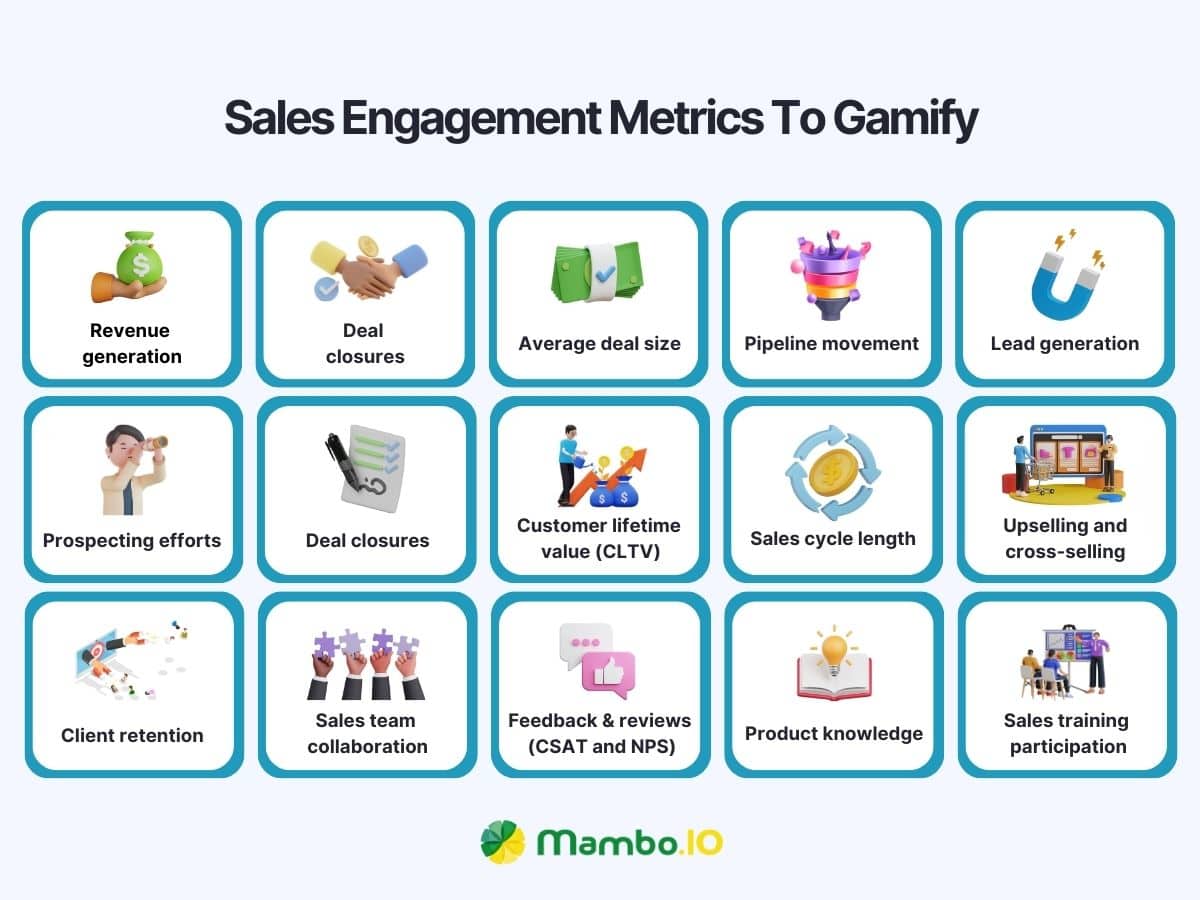
Revenue generation
Revenue generation is the total income your sales team generates through sales of your product or service. By gamifying this metric, you can encourage healthy competition among your sales reps. Consider setting up leaderboards to display top performers and reward them with incentives or recognition. This can fuel their motivation and increase overall sales.
Deal closures
Deal closures represent the number of deals completed. Gamifying deal closures can drive a sense of accomplishment among your sales team. To do this, you can offer rewards or bonuses for reaching specific closure milestones. It’ll push them to close deals more efficiently.
Average deal size
Average deal size is the average monetary value of each deal closed. You’d want to gamify this metric to encourage your team to focus on larger deals. Offering bonuses or recognition for achieving or exceeding a specific deal size can be a powerful incentive. Your company will receive increased revenue if they’ve managed such a feat.
Pipeline movement
Pipeline movement tracks how deals progress through your sales pipeline. KPI gamification allows you to create a game where reps earn points for moving deals through the pipeline stages. Doing so keeps your team engaged and ensures deals don’t get stuck in one stage for too long.
Lead generation
Lead generation measures the number of potential customers interested in your products or services. You can encourage your team to seek new prospects by setting targets for the number of leads generated. If they manage to succeed, they’ll gain rewards.
Prospecting efforts
Prospecting efforts quantify the outreach and activities made to find potential customers. Gamification can motivate your team to make prospecting efforts consistently. Consider things like challenges or competitions, with you rewarding reps for their outreach efforts and successful prospecting.
Customer acquisition cost (CAC)
This metric calculates how much it costs to acquire a new customer. If you want to reduce your CAC, you can offer bonuses to your sales reps whenever they decrease this metric. Remember that they must reduce the CAC while maintaining or improving revenue.
Customer lifetime value (CLTV)
Customer lifetime value (CLTV) assesses the total value a customer brings over their entire relationship with your company. You can use KPI gamification to reward reps who manage to increase CLTV by upselling, cross-selling, or delivering exceptional service.
Sales cycle length
Sales cycle length measures the time it takes to close a deal. To gamify this metric, you must set a target for reducing the sales cycle length. Then, offer incentives for achieving or surpassing it!
Upselling and cross-selling
Upselling and cross-selling involve selling additional (and often higher-priced) products or services to existing customers. To gamify this metric, you can offer incentives for those who have successfully increased the value of existing customer relationships.
Client retention
Client retention is the percentage of customers who continue to do business with your company over a specific period. Encourage your team to maintain and strengthen existing customer relationships by rewarding those who have retained clients. You can offer rewards like incentives, recognition, or a loyalty program.
Sales team collaboration
Sales team collaboration measures how effectively your team works together to close deals and achieve common goals. Gamify this metric by encouraging reps to collaborate on deals and share insights. Reward those who actively contribute to successful teamwork.
Feedback and reviews (CSAT and NPS)
Customer satisfaction (CSAT) and net promoter score (NPS) gauge customer sentiment loyalty. Gamifying this metric involves offering bonuses and recognition for anyone who achieves or surpasses your target CSAT and NPS scores.
Product knowledge
It assesses how well your team understands your offerings and their features. Gamifying this metric ensures your team is well-equipped to answer customer inquiries effectively.
Sales training participation
Sales training participation measures your team’s engagement in training and development opportunities. Gamifying this metric will make sales training fun and rewarding for your team. You can do so by awarding badges, certificates, or even small prizes for completing training modules.
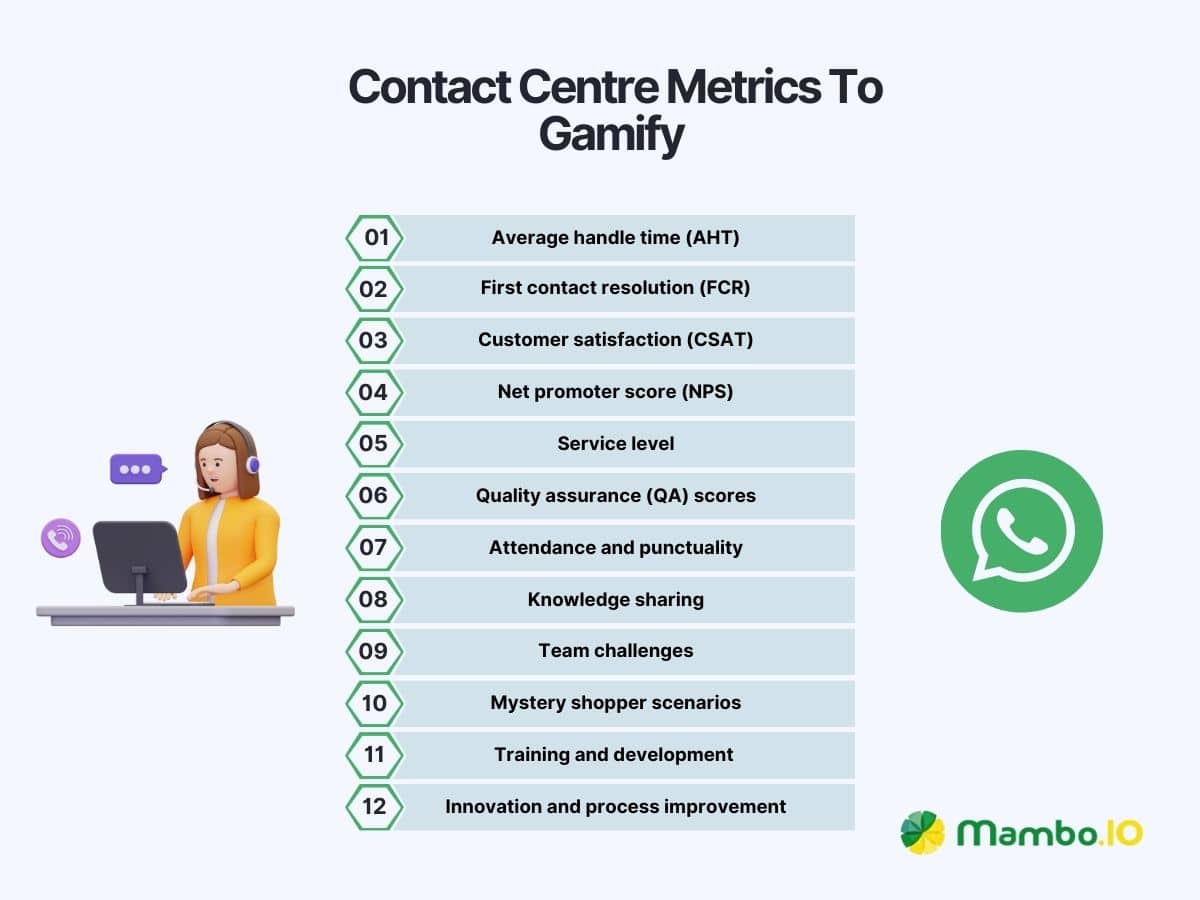
It’s common for contact centres to leverage numerous metrics and KPIs to refine and improve their operations. But how can these centres transform these numbers into motivating tools for their teams?
They can do so all thanks to gamification. This strategy isn’t just about making work “fun”; it’s about harnessing the power of competition, reward, and recognition. By gamifying contact centres and turning everyday tasks into engaging challenges, you can unlock your team’s untapped potential.
Let’s explore some of the most common contact centre gamification metrics and KPIs.
Average handle time (AHT)
Average handle time refers to the average duration it takes for an agent to resolve a customer query. You can achieve AHT gamification by setting time-based goals for agents, encouraging them to find quicker solutions without compromising quality. This fosters competitiveness among your team, driving them to improve their efficiency in handling customer interactions.
First contact resolution (FCR)
First contact resolution (FCR) represents the percentage of customer issues resolved during the initial interaction. If you gamify this metric, you can enhance customer satisfaction and significantly reduce operational costs.
Customer satisfaction (CSAT)
Customer satisfaction (CSAT) measures customers’ satisfaction with your service. By gamifying CSAT, you can incentivise agents to go above and beyond in delivering a stellar customer experience. Be sure to recognise and reward those who consistently receive high CSAT scores to create an improvement cycle.
Net promoter score (NPS)
Net promoter score (NPS) gauges the likelihood of customers recommending your business to others. You can use gamification to motivate agents to turn satisfied customers into loyal promoters.
Service level
Service level measures the percentage of calls or inquiries answered within a predefined time frame. Gamify this metric by setting response time challenges for your team. Competing to meet or exceed service level goals, your agents can enhance efficiency and maintain customer expectations.
Quality assurance (QA) scores
Quality assurance (QA) scores evaluate the interactions between agents and customers. To improve this metric, you can create rewards for agents who consistently achieve high QA scores.
Attendance and punctuality
Attendance and punctuality are critical for maintaining a consistent service level. Gamify this metric by introducing rewards or recognition for agents who consistently adhere to schedules. Doing so can significantly reduce the number of dropped calls or long wait times due to understaffing.
Knowledge sharing
Knowledge-sharing metrics gauge how effectively information is disseminated within your contact centre. This includes tracking the sharing of best practices, customer information, and problem-solving techniques.
You can encourage knowledge sharing through gamified quizzes or challenges. Additionally, you can offer points and rewards for sharing valuable insights or training materials.
Team challenges
This metric focuses on the performance of groups within your contact centre. This could include tracking team achievements or specific project targets. To gamify this metric, you can create friendly competition by dividing your teams into groups and setting up challenges. This fosters a sense of camaraderie and motivates teams to work together toward shared goals.
Mystery shopper scenarios
Mystery shopper scenarios help evaluate your contact centre’s performance from a customer’s perspective. It involves monitoring how agents handle customer interactions.
Use gamification to turn mystery shopper scenarios into fun exercises. Reward agents for exceptional customer service, handling difficult situations, or meeting specific criteria.
Training and development
Training and development metrics assess how well your contact centre equips agents with the necessary skills and knowledge. Gamify your training programs by adding quizzes, simulations, and interactive modules. You can also offer rewards or certificates to agents who complete training milestones.
Innovation and process improvement
Innovation and process improvement metrics focus on identifying areas of improvement for better efficiency and customer satisfaction. You can encourage your team to suggest innovative solutions through gamified idea-sharing platforms to gamify these metrics. Reward those who contribute ideas and participate in process improvement initiatives.
Everyone can agree that the best way to learn is to make the process more fun and engaging. That’s where e-learning gamification shines the hardest.
Learners typically remember just 10% of what they read and 20% of what they hear. However, when engaged in an interactive gamified task, their retention can soar to as much as 90%! Many e-learning platforms have been implementing gamification for years because they make learning more engaging for students.
Gamifying select e-learning metrics can stimulate healthy competition among learners. It also enables you to collect valuable data to optimise your courses! Let’s explore some of the best e-learning gamification metrics and KPIs you can leverage.
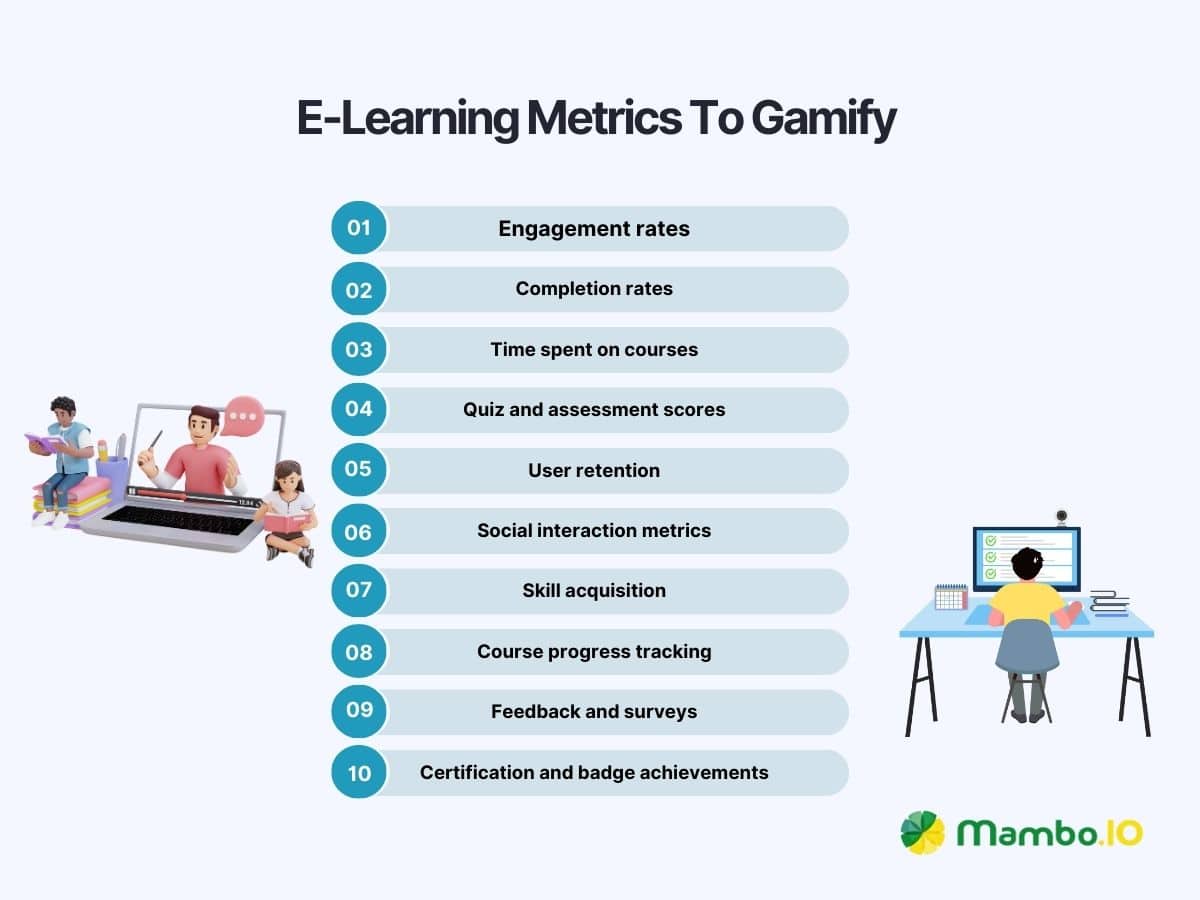
Engagement rates
Engagement rates measure the level of interaction and involvement your learners have with your e-learning content. With gamification, you can encourage active participation by incorporating elements like points, badges, and leaderboards.
Completion rates
Completion rates reflect the percentage of learners who finish a course. Gamification can nudge learners to complete courses by breaking them into smaller, more manageable modules and rewarding progress.
Time spent on courses
The amount of time learners spend on your course is a vital metric. With gamification, you can make learning enjoyable, thus reducing the perception of time spent. Interactive elements like simulations, quizzes, and competitions can make learners want to spend more time in your course.
Quiz and assessment scores
The scores achieved in quizzes and assessments are clear indicators of learning outcomes. You can use gamification to create engaging quizzes with timed challenges and immediate feedback. Doing so provides a sense of achievement and encourages learners to replay quizzes to improve their scores.
User retention
User retention measures how many learners continue using your e-learning platform over time. Gamification can foster community by enabling learners to collaborate and compete with their peers. This sense of belonging and achievement can increase user retention as learners return for more challenges and rewards.
Social interaction metrics
Social interaction metrics measure how learners engage with each other and the learning community. Gamification can transform these interactions by introducing challenges, team competitions, and leaderboards.
Skill acquisition
Skill acquisition metrics gauge how effectively learners acquire and apply new competencies in real-world scenarios. It’s all about whether what you’re learning is making a difference. With gamification, you can inject excitement into learning, making learning practical and more enjoyable.
Course progress tracking
Course progress tracking involves monitoring how learners move through your courses. You can introduce progress bars, badges, and achievement levels to show learners their advancement.
Feedback and surveys
Feedback and surveys are essential to assess learner satisfaction, gather insights, and make improvements. These metrics indicate how well your e-learning platform aligns with learners’ needs and expectations.
Certification and badge achievements
These metrics highlight the learner’s achievements and credentials earned through your course. With gamification, you can make the journey to certification or badge achievements exciting. Encourage learners to strive for recognition and showcase their accomplishments.
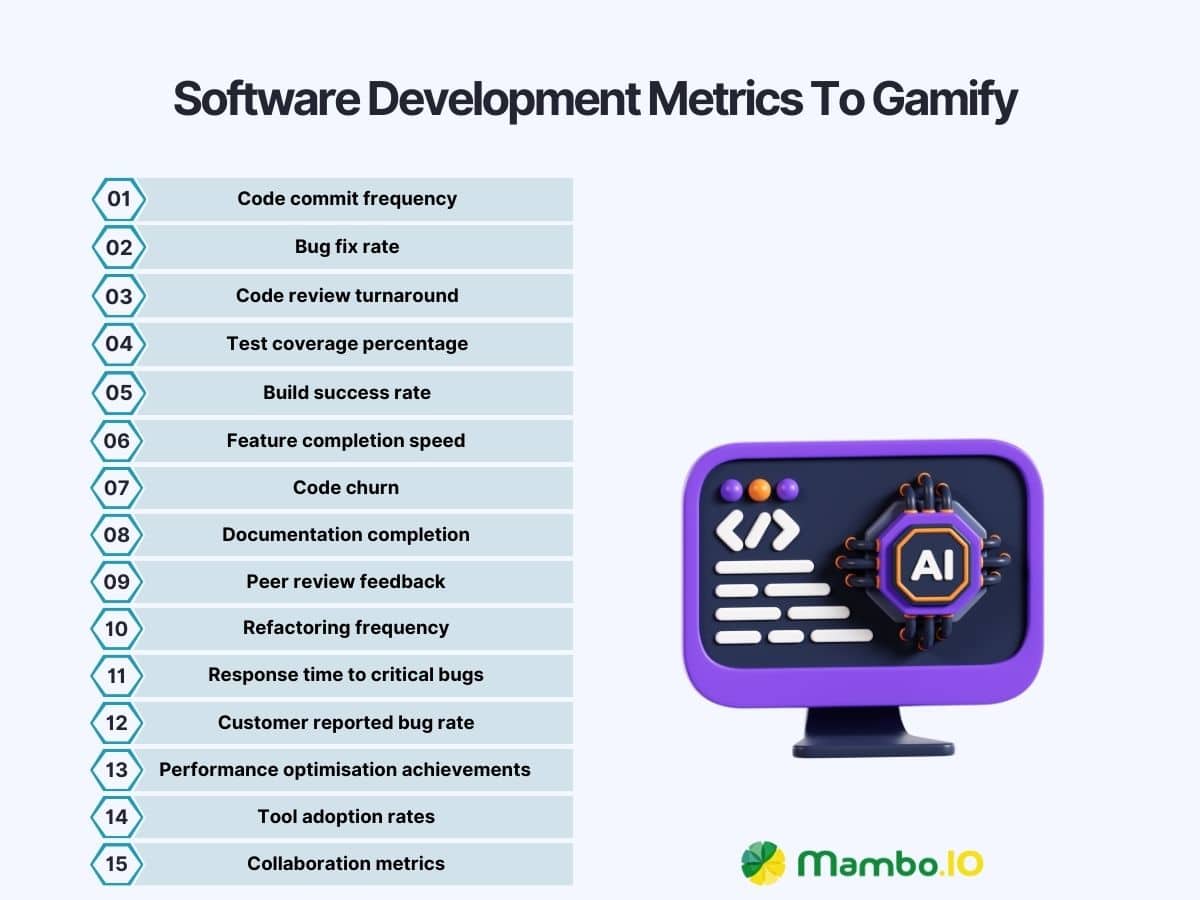
If you’ve ever felt that the software development process could become a monotonous grind, you’re not alone. With gamification, you can turn that tedious work into an engaging and fun experience for your development team.
Gamifying the right metrics can incentivise your team, improve productivity, and make the development process more transparent.
Let’s uncover the most common software development gamification metrics and KPIs today.
Code commit frequency
Code commit frequency measures how often developers submit changes to a code repository. Frequent admits are generally encouraged as they make identifying and fixing issues easier, speeding up the development process. Utilising gamification metrics and KPIs here can incentivise regular code submission and documentation.
Bug fix rate
The bug fix rate metric tracks the number of bugs identified and resolved within a specified period. A high bug fix rate is a positive indicator of a team’s responsiveness to issues. A gamified bug tracking and fixing process may involve creating badges to encourage timely fixes and celebrate achievements. We’re talking about badges like “Bug Hunter of the Month” or something cooler!
Code review turnaround
This metric measures the time needed for the submitted code to be reviewed, approved, or turned in for revisions. A shorter turnaround time generally indicates a more agile and responsive team. Focusing on metrics like this encourages a culture of quick yet thorough code reviews.
Test coverage percentage
This metric gauges the proportion of your codebase tested by automated tests. The higher the test coverage percentage is, the lower the risk of bugs slipping through the cracks. Gamify this metric by setting up challenges where developers aim to achieve a target test coverage percentage for each sprint. Then, reward those who meet or exceed the target with recognition or small incentives.
Build success rate
Build success rate measures how often code changes result in a successful build. A high success rate indicates a healthy codebase and strong development practices amongst your team. Utilise gamification here to track individual contributions to success builds. And in doing so, you can provide added motivation to your team so they can write clean and error-free code.
Feature completion speed
This metric measures a development team’s time from conceptualising a feature to delivering it. It’s generally measured in days or hours and indicates the team’s productivity and efficiency. Gamification metrics and KPIs here could include average completion time over a set period and the number of badges earned.
Code churn
Code churn refers to the percentage of a developer’s recent coding edits that are subsequently changed or deleted quickly. A high churn rate can indicate indecisiveness, lack of clarity, or low code quality. Combat this by awarding developers who maintain low churn rates with points that can be redeemed for real-world benefits. Does extra time off or team lunches sound good?
Documentation completion
This metric measures the completeness and quality of a project’s documentation. It could range from user guides to inline code comments. More importantly, it often correlates with the ease of onboarding new team members. Gamifying this metric can look like awarding team members who consistently contribute to or improve project documentation.
Peer review feedback
Peer review feedback involves the qualitative and quantitative aspects of feedback received during code reviews. This can include several issues caught, the usefulness of the feedback, and even the timeliness of the review. Try creating a point-based system where reviewers earn points for timely and valuable feedback to gamify this metric.
Refactoring frequency
Refactoring frequency tracks how often code is updated or improved without changing external behaviour. It’s an essential part of maintaining code quality and sustainability over time. You can use gamification metrics and KPIs to track the impact of refactoring on code quality and overall system performance.
Response time to critical bugs
This metric measures the time teams need to fix critical bugs after they have been reported. Time is of the essence here, so the quicker the response, the less damage the bug can make. Gamify this metric by setting up a leaderboard and rewarding those quickly resolving critical bugs.
Customer-reported bug rate
The customer-reported bug rate focuses on the number of bugs reported directly by end-users. Lower rates typically indicate a more robust software. Incorporate gamification metrics and KPIs by rewarding teams or individuals who maintain the lowest bug rate over specific periods. Then, you can make this achievement visible company-wide to acknowledge and incentivise best practices.
Performance optimisation achievements
This metric captures the efficiency improvements in your software. Think of it as a scoreboard for your engineer’s skill in optimising code for better performance. To gamify this, you can set up challenges that encourage team members to optimise different aspects of your software. Use gamification metrics and KPIs to award points for each successful optimisation and track these on the scoreboard.
Tool adoption rates
This metric gauges how quickly and comprehensively your team adopts new software tools. Higher adoption rates signal that a tool is effective and user-friendly. To gamify this metric, you can provide rewards or badges for each completed training module related to the new tool. Doing so makes adopting new technologies a more engaging and rewarding experience.
Collaboration metrics
Collaboration metrics quantify the level of effectiveness of teamwork within your development unit. This could involve cross-functional collaboration or even simple peer code reviews. Try leveraging gamification metrics and KPIs to incentivise team collaborations. For example, you could award points for successful joint projects or collaborations that lead to problem-solving.
Marketing involves numerous metrics and KPIs. Admittedly, there are so many of them to track! Thankfully, some of them stand out, and most of them can benefit greatly from gamification.
This strategic approach is a game-changer that enables your marketing team to get your message out more efficiently and effectively.
Let’s dive in and explore the marketing metrics you can gamify.
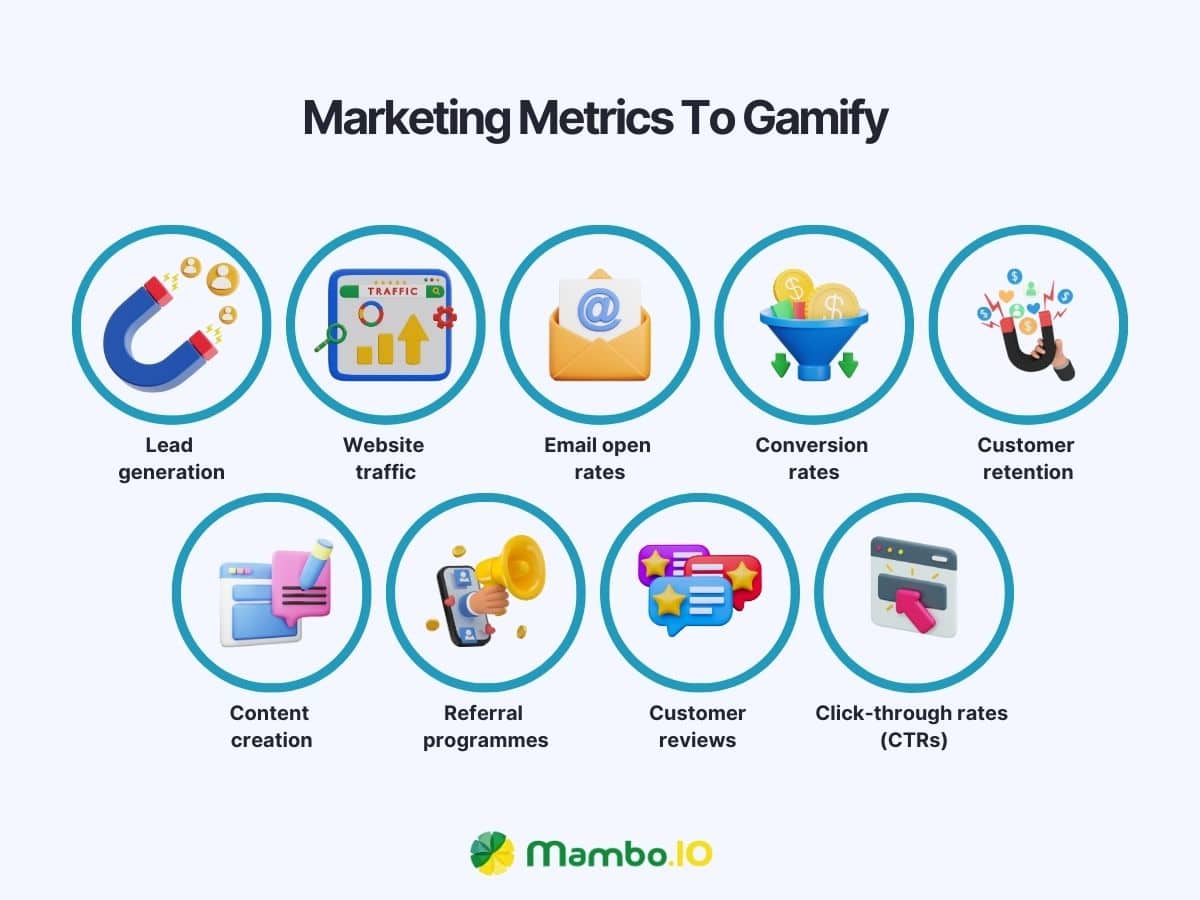
Lead generation
Lead generation is about attracting potential customers who have shown interest in your product or service. By gamifying lead generation, you can capture more leads and gather valuable insights.
Website traffic
Website traffic measures the number of visitors your site receives. To gamify this metric, encourage users to stay longer by making the navigation fun and interactive. The longer they stay on your platform, the more likely they are to get converted into paying customers!
Email open rates
Email open rates indicate how many people open your marketing emails. You can use gamification to craft enticing email subject lines and content that pique the recipient’s curiosity. Having a system where subscribers earn rewards for opening and engaging your emails can increase open rates, driving more conversions.
Conversion rates
Conversion rates measure the percentage of visitors who take the desired action or behaviour on your website. Gamification can make the conversion path more engaging and enjoyable, leading to higher conversion rates.
Customer retention
Customer retention is a metric that focuses on keeping existing customers satisfied and loyal. With gamification, you can foster a sense of belonging and appreciation, significantly boosting customer retention.
Content creation
Content creation encompasses crafting blog posts, videos, infographics, and materials that resonate with your audience. Gamifying this metric can lead to higher-quality content.
Referral programmes
Referral programmes are designed to motivate customers to refer friends and family to your business. With gamification, you can transform customers into enthusiastic advocates, which creates a ripple effect of word-of-mouth marketing.
Customer reviews
Customer reviews are all about feedback, ratings, and testimonials from your valued customers. To get the best out of this metric, you can make leaving reviews a rewarding experience. You can do so by offering badges or rewards to customers who provide feedback. Additionally, recognise those who offer valuable insights about your product.
Click-through rates (CTRs)
Click-through rates (CTRs) measure the effectiveness of your online marketing efforts. It does so by tracking the percentage of users who click a specific link.
One good strategy to gamify this metric is to motivate your marketing team to craft compelling calls-to-action (CTAs). If they manage to boost your CTRs, reward them.
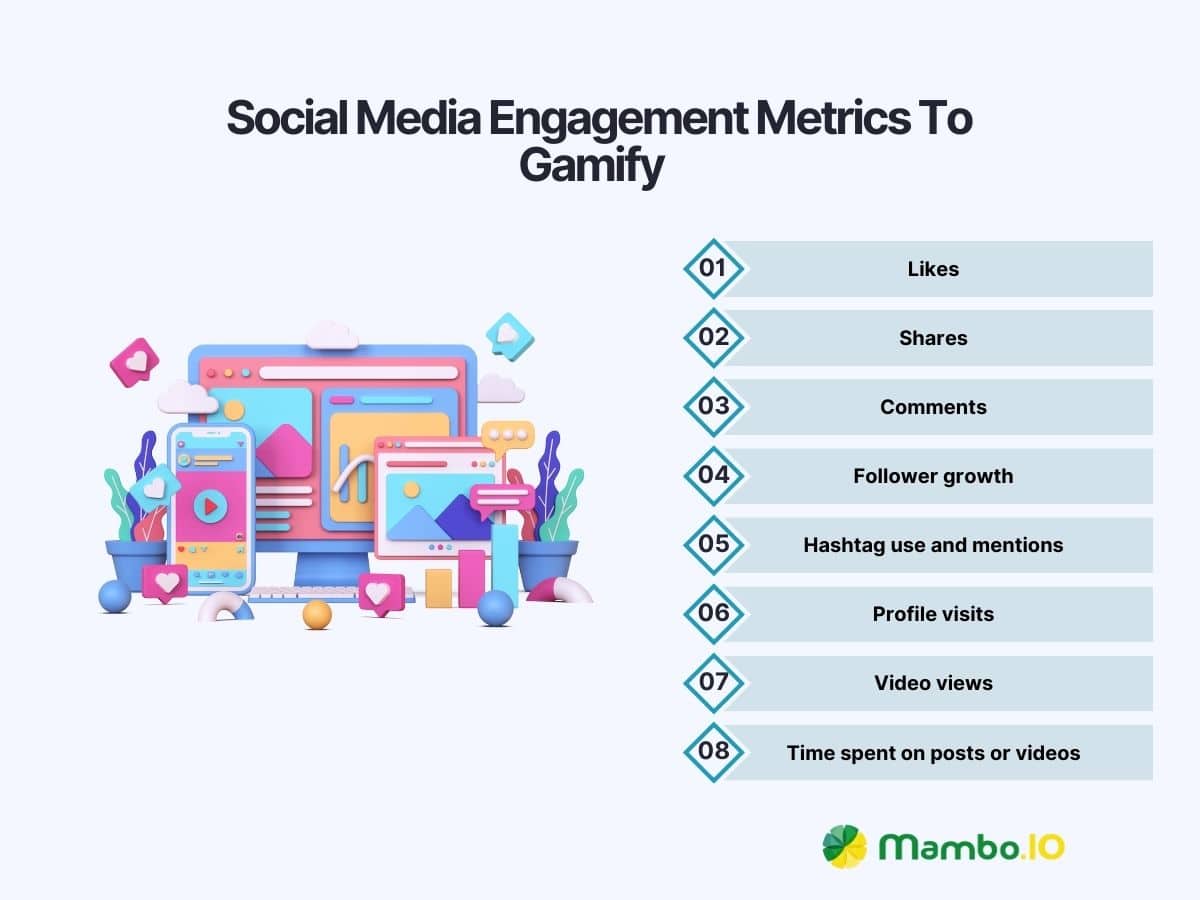
Gamification has emerged as a powerful strategy for businesses aiming to boost engagement on their social media channels. When you set the right gamification KPIs, you will achieve the results you envision for your brand. Thankfully, there are plenty of social media engagement metrics that you can gamify, and here are some of them.
Likes
Likes represent the number of users who appreciate your content. When you gamify this metric, you encourage users to compete for the most likes by rewarding top contributors.
Shares
Shares indicate how many users found your content compelling enough to be shared with their network. A great idea to gamify this metric is to reward users for sharing content. For example, offer giveaways or exclusive access to content for a lucky random few who shared the content.
Comments
Comments measure the level of interaction and discussion your content generates. Gamifying this involves integrating elements like rewards like recognition and badges for the most insightful comments.
Follower growth
Follower growth measures the rate at which your audience is expanding. To gamify this metric, you can initiate “refer-a-friend” campaigns that reward users for bringing in new followers. Then, offer incentives for achieving specific milestones.
Hashtag use and mentions
Tracking hashtag use and mentions helps you understand how your brand is being discussed and discovered. One of the best ways to gamify this metric is to acknowledge and reward those who consistently mention your brand.
Profile visits
Profile visits show how many users are curious enough to explore your profile. Reward users who visit your profile frequently with exclusive content or discounts. Not only that, you can make this system a part of a loyalty programme.
Video views
Video views measure how many people watched your videos. You can gamify this metric by setting up video challenges with rewards for those who watch your content consistently.
Time spent on posts or videos
The time spent on posts/videos tells how long users engage with your content. Gamifying this metric often involves strategies like promoting engagement through contests.
There are multiple benefits you can enjoy from gamifying your website. For starters, gamifying a website can lead to around 100% to 150% increase in engagement metrics! Doing so can also boost content discovery by 68% and increase social sharing by 22%. Does it sound too good to be true? It is, but the good news is it’s achievable.
Before you implement the right gamification strategy for your website, you must know the metrics and KPIs you must target.

Pageviews and unique visitors
Pageviews are the total number of pages your visitors view on your websites. As for unique visitors, they represent the number of unique visitors who access your website. Gamifying these metrics involves turning page exploration into a captivating journey.
Conversion rate
Your website’s conversion rate is a key indicator of how effectively it turns visitors into customers, subscribers, or leads. Gamifying this metric means introducing challenges or quests for users to complete. You can reward them with discounts, badges, or other incentives when they accomplish these tasks.
Bounce rate
This metric measures the visitors who “bounce” away from your website after viewing only one page. Gamification can make a significant difference by providing an interactive element in user experience. Try implementing quizzes, polls, or other interactive content to reduce bounce rates.
Average session duration
The average session duration is essential for understanding how long visitors spend on your site. Gamification can boost this by creating engaging activities or challenges that keep users hooked. Consider time-limited tasks, story-driven experiences, or rewarding users for staying on your site longer.
Click-through rate (CTR)
The click-through rate is vital for evaluating the effectiveness of your calls to action. Encourage users to click through by making it visually appealing or offering rewards for specific actions. Doing so can ultimately boost your website’s user engagement.
Lead generation
Lead generation identifies and attracts potential customers, and gamification works wonders here. Consider creating interactive quizzes, contests, or spin-the-wheel games where users can participate in exchange for sharing their contact information. This not only makes lead generation more enjoyable but also increases the number of leads you capture.
Form submission
Form submission metrics reflect the number of users who complete forms on your site, like contact or subscription forms. You can apply gamification here by adding a progress bar to the form or offering rewards for completing it. Doing so can make the process more appealing, thus increasing form completion rates.
Social shares and referrals
Encouraging social shares and referrals is vital for expanding your online presence. Gamification can come into play when incentivising users who share your content and refer others. This spreads the word about your business and cultivates a sense of community among your audience.
Customer engagement metrics (comments, likes, reviews)
Boosting your customer engagement metrics involves encouraging users to interact with your content. With the help of gamification, you can make this process more exciting. You can introduce challenges or competitions where users can earn points or badges for leaving comments or liking posts.
eCommerce metrics (cart adds, checkouts, revenue)
Every action counts in the eCommerce industry. Because of this, eCommerce metrics like cart additions, checkouts, and revenue are essential for your business’ success.
To achieve this, you can apply gamification by offering discounts, special offers, and loyalty rewards when users reach specific milestones. Doing so encourages users to spend more and return for future transactions.
Search engine ranking
Your website’s retention rate measures how well you’re keeping your users engaged and returning for more. Gamifying this metric means turning one-time visitors into loyal fans. Additionally, doing so can increase your retention rate and build a dedicated user base.
User feedback and surveys
User feedback is invaluable for improvement, and turning it into a game can make it more engaging. To implement gamification metrics and KPIs, you can offer incentives for completing surveys or providing feedback. This could be in the form of contest entries, discounts, or virtual rewards.
Mobile responsiveness
Mobile responsiveness is a crucial metric in today’s mobile-centric world. Gamification here means rewarding users for reporting mobile responsiveness issues.
To do this, you can set up a system where users earn points or recognition for identifying and reporting problems. This helps you maintain an error-free mobile experience and involves your users.
Search engine ranking
Your search engine ranking directly impacts your online visibility. Gamify this metric by introducing a competitive element on your website. Encourage your users to share your content or improve your SEO in specific ways.
Error and bug reporting
Reporting errors and bugs is often mundane, but it’s essential for maintaining a seamless user experience. Luckily for you, gamification can make this more appealing. Try creating a system where users can earn points or rewards for reporting bugs. This helps in early error detection and fosters a sense of community engagement.
Did you know gamification has also been making ripples in the healthcare industry? Gamified healthcare and wellness programmes can significantly enhance patient engagement and treatment adherence.
You can use many gamification metrics and KPIs to elevate your patient’s experience and realise substantial cost savings. Let’s explore some of them below.
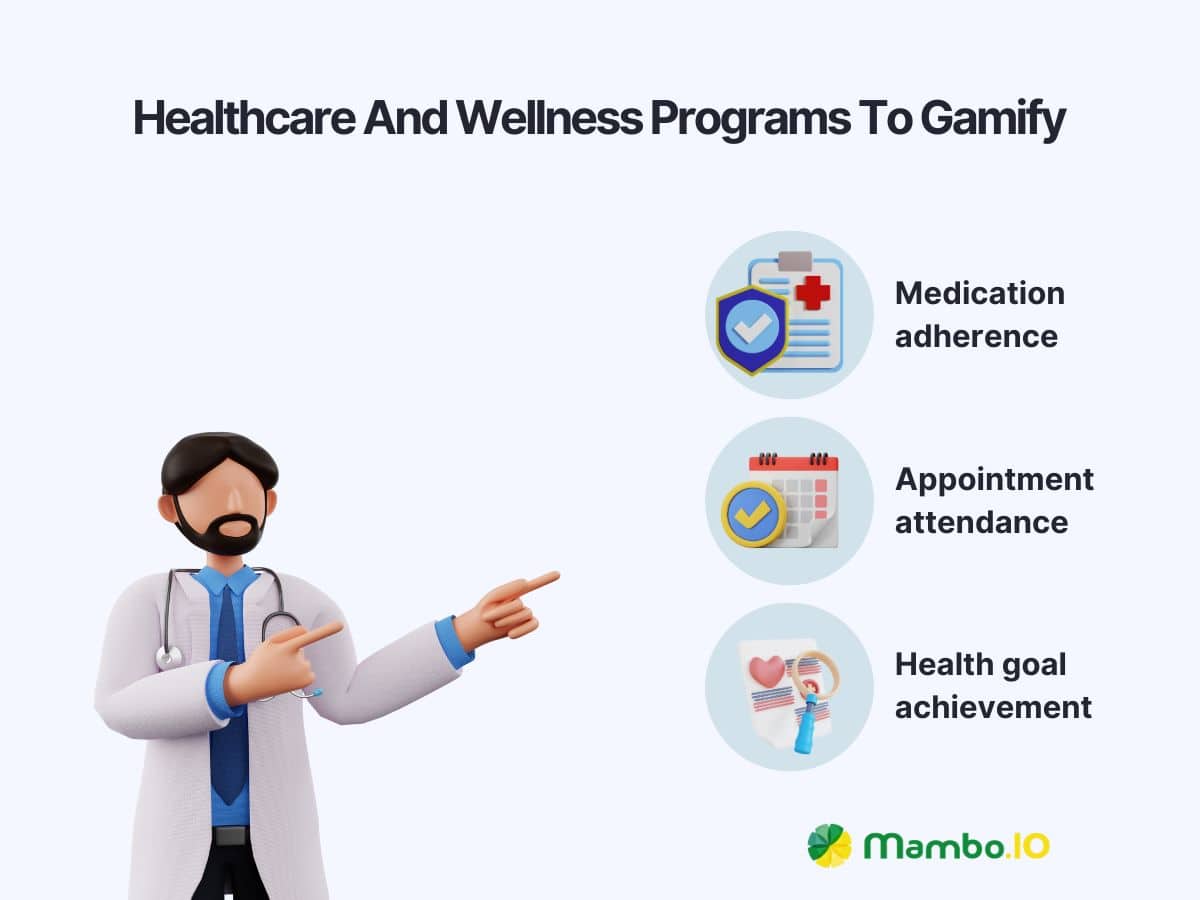
Medication adherence
Medication adherence measures how well patients follow their prescribed medication regimen. It’s often expressed as a percentage, representing the number of doses taken as prescribed divided by the total prescribed doses.
By gamifying this metric, you give patients instant gratification for taking their medications on time. Ultimately, this helps them form a healthy habit that would benefit them in the long run.
Appointment attendance
This metric tracks how consistently patients show up for their medical appointments, whether they’re routine check-ups or crucial treatment sessions. By incorporating points, prizes, or progress-tracking systems, you create a sense of patient commitment and responsibility.
Health goal achievement
Health goal achievement measures how well individuals meet their wellness targets, such as maintaining healthy blood pressure or cholesterol levels. Gamifying this metric turns the pursuit of health into a satisfying game.
Let’s face it: working out for the sake of working out is boring! Apps and platforms centred on fitness and wellness know this full well. To combat this, they often incorporate game elements to continuously drive their users to achieve their respective fitness goals. Here are some of the fitness and wellness metrics that are usually gamified.

Steps taken
This metric counts the number of steps the user takes throughout the day. It’s a great way to measure their daily physical activity. Gamifying this metric can encourage users to move more.
Distance covered
This metric calculates the distance a user travels, including walking, running, or any other physical activity. Transforming this metric can motivate users to explore new routes, try different workout routines, and push their limits.
Calories burned
This metric represents the calories expended during physical activity. It’s a crucial metric for weight management and overall fitness. There are many ways to gamify this metric, such as virtual rewards, badges, and competitions.
Workout frequency and duration
This metric tracks how often someone works out and how long each session lasts. It indicates a person’s commitment to their fitness routine. By gamifying this metric, you incentivise users to do their workout routines consistently.
Health goals achieved
This metric focuses on health objectives like weight loss, muscle gain, and cholesterol reduction. Ultimately, it reflects the purpose of a user’s fitness journey. Gamifying this metric will make the user feel better about their achievement, thus motivating them to accomplish other fitness goals.
Gamification is a potent productivity booster, and it’s something that individuals and teams should utilise to the fullest. According to Zippia, a staggering 90% of employees say that gamification enhances their productivity at work.
The metrics below are examples of the productivity and time management metrics you can use to boost your team’s efficiency.
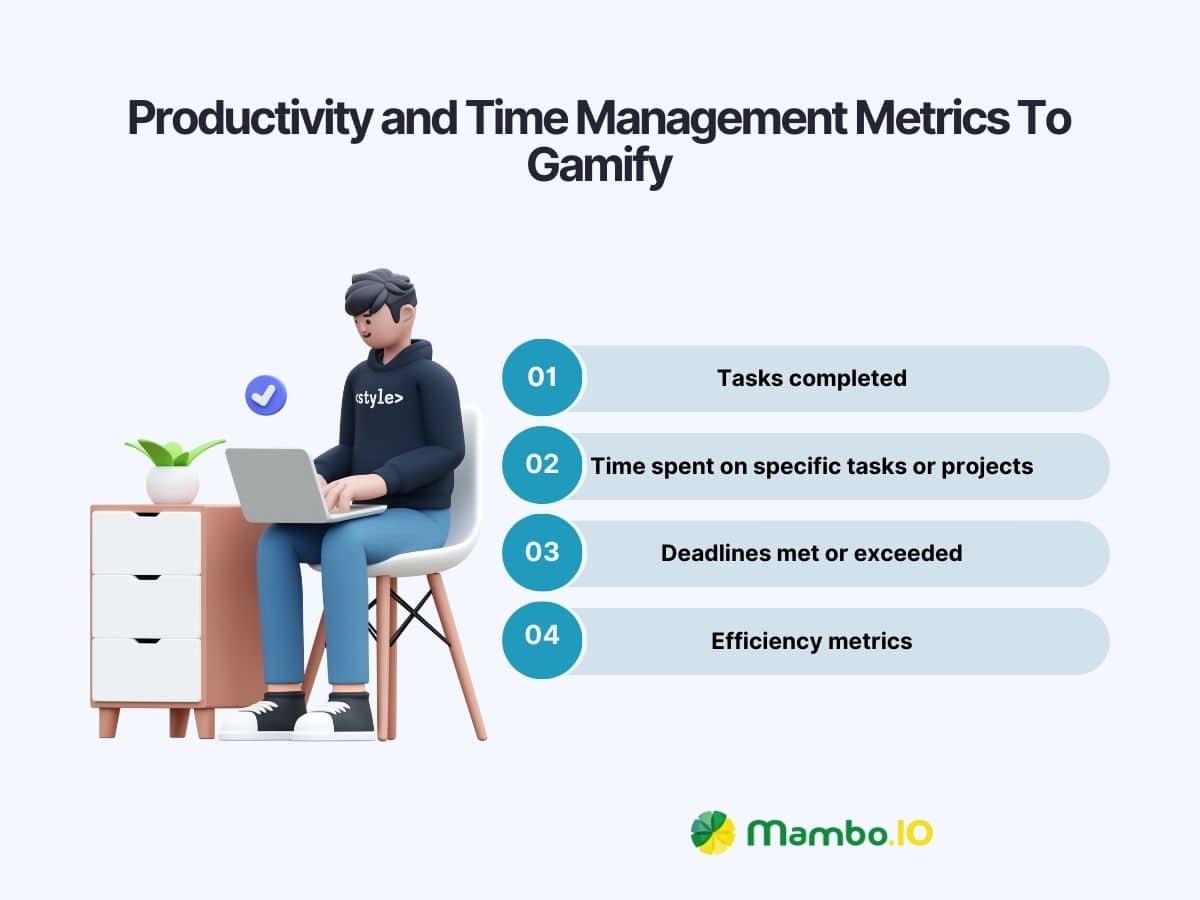
Tasks completed
Tasks completed measure the number of tasks or assignments accomplished within a given timeframe. Gamifying this metric can transform the way your team tackles their to-do lists.
Time spent on specific tasks or projects
This metric monitors the amount of time dedicated to particular tasks or projects. If you gamify this metric, you can inspire your team to manage their time on different tasks better.
Deadlines met or exceeded
This metric gauges how consistently your team finishes their work within established deadlines or, even better, ahead of schedule. By incorporating rewards, recognition, or even penalties, you can encourage a culture of timely task completion.
Efficiency metrics
Efficiency metrics such as tasks completed per hour assess how much work your team can complete in a specific period. Gamifying this metric can make your team race against the clock in a fun and motivating way.
Businesses across sectors have been actively using gamification to amplify employee engagement, performance, bolster satisfaction, and improve retention.
The key is understanding and implementing the right employee performance gamification metrics and KPIs. Doing so can lead to a more engaged and high-performing workforce.
Let’s examine some of the most crucial employee performance metrics you can gamify.

Goals achieved
This metric measures employees’ targets or objectives within a set timeframe. By gamifying this metric, you can create a sense of accomplishment and competition among your team. Over time, this can increase productivity as individuals strive to outperform their peers.
Performance ratings
Performance ratings summarise an employee’s overall effectiveness and are often represented as a numerical score. To gamify this, you can create an engaging system for performance ratings by transforming them into a continuous improvement game. This will encourage your employees to set goals for improving their scores.
Feedback received from peers or superiors
This metric evaluates the quality and quantity of feedback an employee receives from colleagues or superiors. Positive feedback can be rewarded, thus promoting a culture of constructive communication and personal growth.
Gamification is also present in online communities. It has been used repeatedly to motivate, engage, and give members unique and memorable experiences.
Gamification has this innate ability to leverage both intrinsic and extrinsic motivation to drive user’s interest. And once this interest has been churned, they’re more likely to do the actions beneficial to your community.
Let’s look at three of the most common community engagement gamification metrics and KPIs.
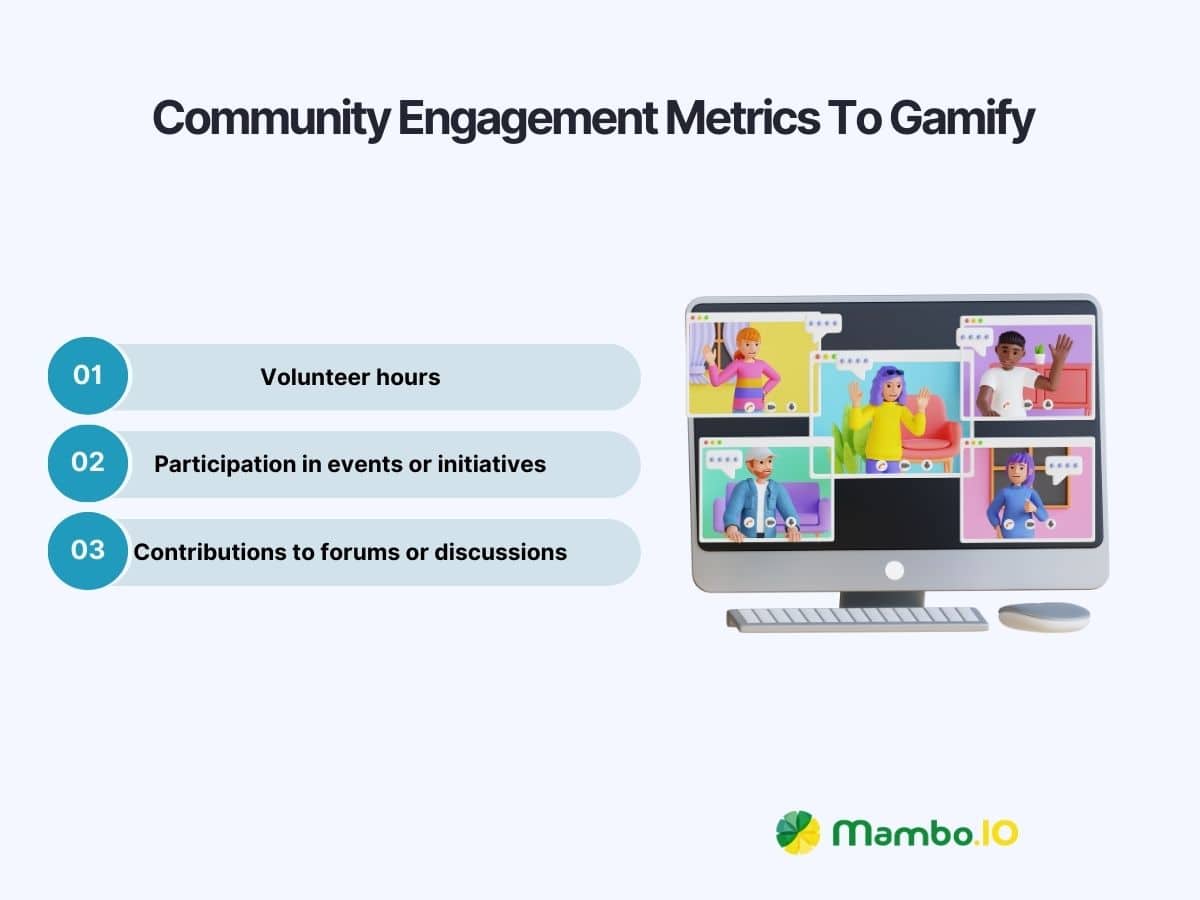
Volunteer hours
Volunteer hours is a metric that measures the amount of time individuals willingly invest in their community without financial gain. This could be helping at events, supporting various causes, or even contributing their expertise. Gamifying this metric makes volunteering more exciting for the end user.
Participation in events or initiatives
This metric tracks the number of community members participating in your organisation’s initiatives. It’s an indicator of how engaged your community is in your activities. Gamifying this metric creates a sense of progression and motivates participants to engage with your initiatives.
Contributions to forums or discussions
This metric measures the quantity and quality of contributions made by community members in your forums or discussions. If you gamify this metric, you can transform your community into a valuable knowledge-sharing hub.
Gamification leverages elements of game design and psychology to influence user behaviour positively. By applying gamification techniques strategically, your business can encourage users to take desired actions that directly impact your KPIs.
Here’s how gamification can track and improve your organisation’s KPIs.

By defining and tracking user behaviours
Behaviours are one of the building blocks of any successful business operation, be it customer actions or employee performance. Understanding and influencing these behaviours is where the rubber meets the road for your KPIs. By defining and tracking user behaviours, let’s dive deeper into how gamification tracks and improves KPIs.
Defining and rewarding critical behaviours
Organisations use gamification to measure and improve engagement by rewarding actions that keep users active. For instance, they offer points for logging in daily, completing specific tasks, or referring friends. Organisations will gain more actionable metrics to enhance their KPIs as users engage more to earn rewards or level up.
Gamification forces you to answer:
“What behaviours matter most to your KPIs?”
Once identified, these should be explicitly defined in your gamification platform. It’s about rewarding any action and incentivising those directly impacting your KPIs. Whether completing a training module or hitting sales milestones, ensure these behaviours are tagged and rewarded within the system.
Clear communication of important behaviours
Gamification thrives with transparency. With this in mind, your team must know which behaviours are critical for achieving the KPIs. Clear communication, coupled with the inherent engagement of gamification, is an effective strategy for boosting performance. In this sense, your gamification metrics and KPIs aren’t just measurements but motivational tools.
Deep-dive analytics for insight
Metrics like page views are just surface-level; behaviour analytics is where the treasure is. Gamification allows you to break down and analyse behavioural data to give you new insights into improving your KPIs. This level of insight offers granularity that more basic metrics can’t provide.
By providing real-time feedback with notifications
One of the most potent tools in gamification is real-time feedback through notifications. Why is this so crucial? Feedback loops are vital for any organisation aiming to perform at peak levels.
Let’s explain how gamification uses real-time feedback to track and improve your KPIs.
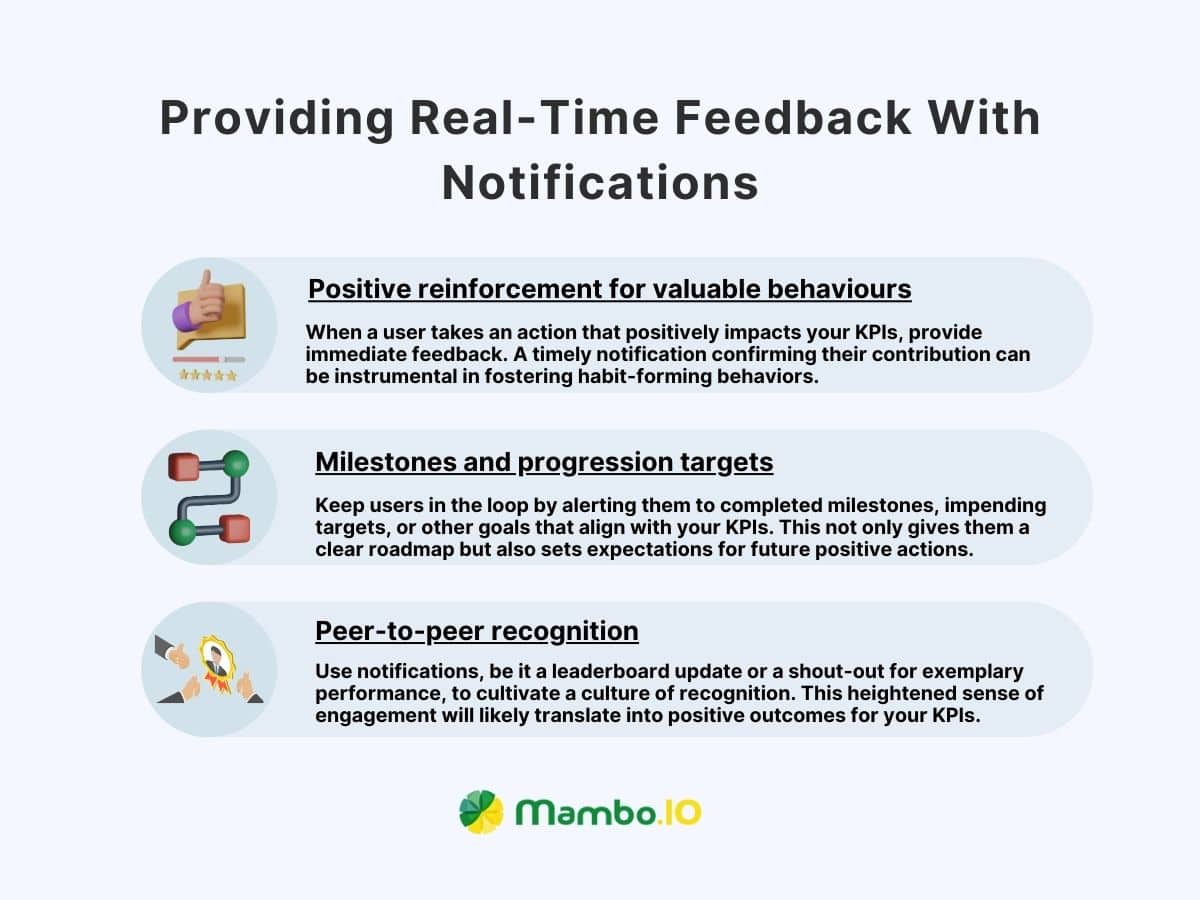
Positive reinforcement for valuable behaviours
This is Psychology 101 – people are more likely to repeat an action if they get a positive response. If a user acts beneficial to your KPIs, let them know immediately. A simple notification that validates their effort can go a long way in building habit-forming behaviours. Remember that it’s not just about distributing rewards; it’s about reinforcing actions you want to see more often.
Milestones and progression targets
Your users aren’t mind readers. How will they aim for them if they don’t know the targets?
This dilemma is where real-time feedback shines. Keep your users updated by notifying them of completed milestones, upcoming targets, or other goals aligned with your KPIs. Doing so provides a roadmap for what positive actions you can expect. Moreover, it offers the user a sense of accomplishment as they tick off these objectives.
Peer-to-peer recognition
Social proof is powerful in any community, and a public pat on the back can be a huge motivator.
This is where gamification metrics & KPIs offer a unique advantage – spotlighting peer-to-peer recognition through instant notifications. Whether it’s a leaderboard update or a shout-out for a job well done, these notifications create a culture of recognition. This drives engagement, which in turn is likely to have a positive impact on your KPIs.
By increasing awareness, engagement, and motivation through activity streams
Activity streams provide real-time updates about user actions, rewards, and more. Think of them as the pulse of the community established around your product. Let’s unpack how these can be a vital tool for your KPIs.
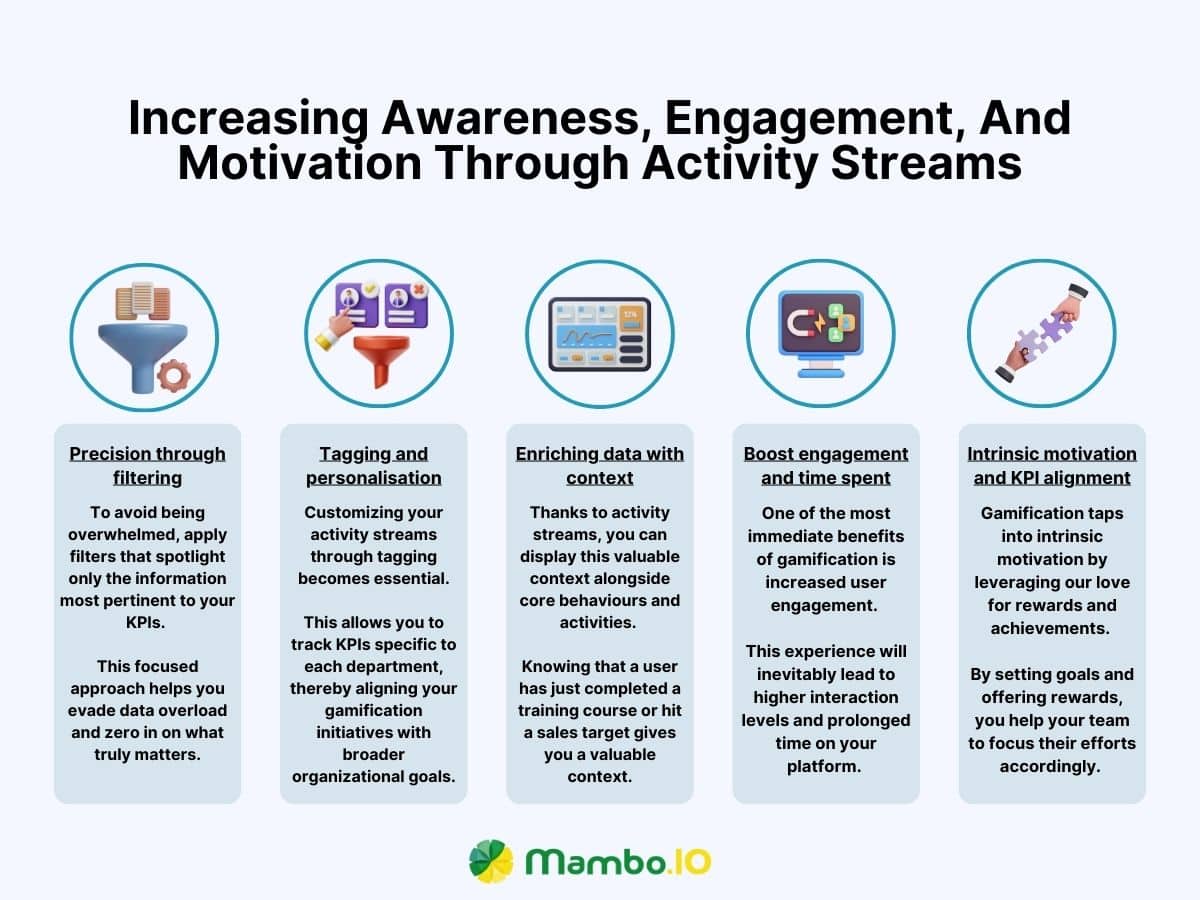
Precision through filtering
Data overload is a real challenge, and activity streams can potentially drown you in too much information. To avoid this, you can employ filters only to display data most relevant to your KPIs. Whether you’re focusing on user behaviours, rewards, or specific activities, these filters allow you to take targeted action. Doing so ensures more effective management of KPIs.
Tagging and personalisation
You can customise your activity streams through tagging if you oversee a complex environment. Tailor the streams to specific departments by creating individualised tags like “HR stream” or “Sales Stream”. Doing so enables you to monitor the KPIs relevant to each department, ensuring alignment between gamification efforts and organisational objectives.
Enriching data with context
Contextual information adds an extra layer to your data. You can display this valuable context alongside core behaviours and activities thanks to activity streams. Knowing that a user has just completed a training course or hit a sales target gives you valuable context. This information helps you gauge the health and effectiveness of your KPIs.
Boost engagement and time spent.
One of the most immediate benefits of gamification is increased user engagement. Elements like points, badges, and leaderboards make the user experience more engaging. This experience will inevitably lead to higher interaction levels and prolonged time on your platform. These metrics directly feed into KPIs focused on user retention and overall engagement.
Intrinsic motivation and KPI alignment
Gamification taps into intrinsic motivation by leveraging our love for rewards and achievements. This is particularly useful when you’re managing teams with specific performance metrics. By setting goals and offering rewards, you help your team to focus their efforts accordingly. This, in turn, will lead to better alignment with set KPIs.
By gaining insights and measuring the impact
Gamification isn’t just about throwing badges and points at your users. It’s more about instilling motivation and encouraging specific behaviours that align with your business goals. But to know if your efforts are working, you must measure it by gaining insights and measuring its impact.
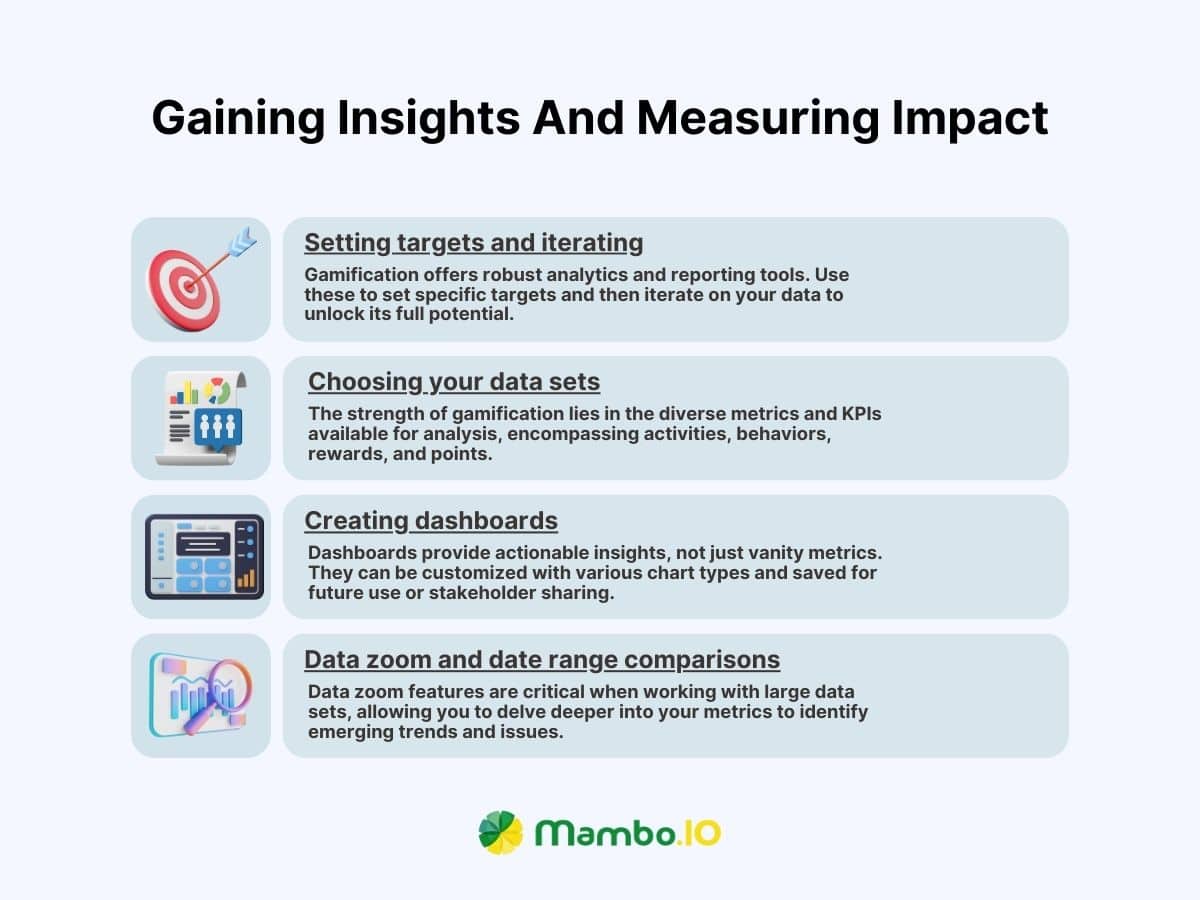
Setting targets and iterating
Gamification involves robust analytics and reporting functionalities. With these in place, you can set specific targets to aim for. Once you have all the necessary data, you must iterate and continuously refine it to maximise its potential.
Choosing your data sets
The beauty of gamification metrics & KPIs is the vast variety of data sets you can analyse. This can include metrics related to activities, behaviours, rewards, and points.
Want to know what motivates users daily? There’s a data set for that. Are you curious about how behaviours trend over time? That’s another data set for you to play around.
Creating dashboards
Now let’s organise all this data. You can group related data sets to create a personalised dashboard showing your programme’s performance. These aren’t just vanity metrics; they’re actionable insights that can drive your decision-making process. Dashboards can be customised further with different chart types and even saved for future reference or sharing with other stakeholders.
Data zoom and date range comparisons
Features like data zoom can be invaluable for those dealing with large data sets. This lets you drill into your metrics, spotting trends and issues that might not be obvious at first glance. Comparing date ranges can help you understand how seasonal trends or specific marketing initiatives impact your KPIs.
By measuring and rewarding progress
Winners will always try their best to achieve something important to them. This is one of the reasons why recognising and rewarding top performers is a critical aspect of gamification.
It’s also essential for any business to make their customers feel appreciated and happy. Thanks to gamification, organisations can reward their users for loyalty and engagement. They often create a system where customers can earn purchase points, leave reviews, or refer others. These rewards foster customer loyalty and provide clear metrics to track and improve customer retention and satisfaction.
But before you can give rewards, you need to be able to measure your user’s progress first. Let’s explore how gamification improves your KPIs by measuring and rewarding participants’ progress.
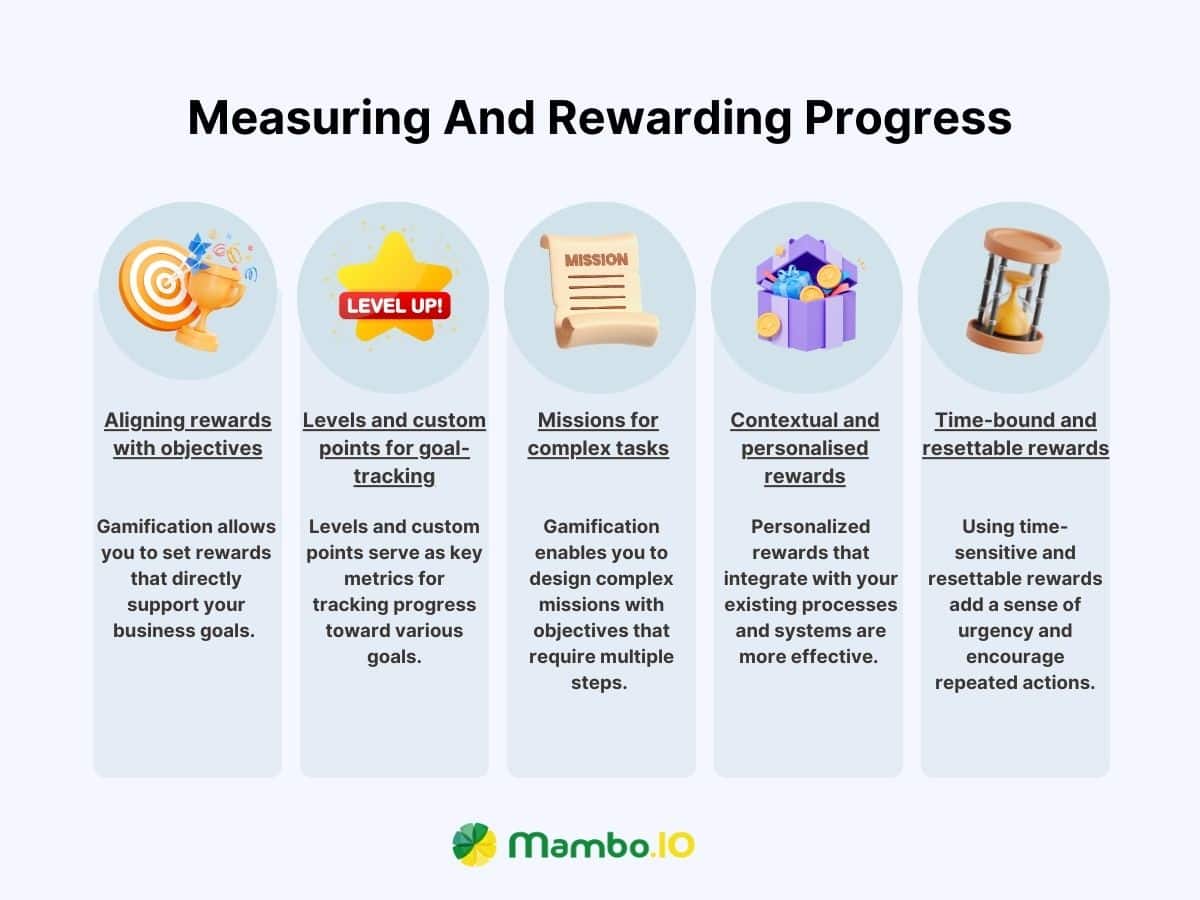
Aligning rewards with objectives
Gamification enables you to define many rewards that align with your business objectives. What does this mean for your business?
Let’s say your KPI is increasing user engagement on your platform. In this case, you could set up a reward for users who log in five days in a row. This incentive naturally encourages more consistent use of your platform.
Levels and custom points for goal-tracking
Next up are your levels and custom points. These gamification metrics and KPIs are crucial for tracking progress towards any goal, whether customer retention or employee performance. These levels act like milestones on the way to achieving a larger objective. When users reach these milestones, they feel a sense of accomplishment that fuels further engagement.
Missions for complex tasks
Thanks to gamification, you can implement complex objectives that can’t be achieved through a single action. Missions allow you to structure related rewards to incentivise the completion of complex tasks or business processes. For instance, a mission might be for a sales rep to close a deal with a big client. Doing such a big task requires initial contact, a presentation, and a follow-up.
Contextual and personalised rewards
You need rewards that fit seamlessly into your existing business processes and applications. Personalisation ensures that these incentives are relevant and meaningful to users to amplify their effectiveness. As a result, they’ll strive harder to improve your KPIs.
Time-bound and resettable rewards
Lastly, consider time-bound and resettable rewards for gamification metrics and KPIs that require repeated behaviour to meet recurring objectives. These create urgency and foster repetition. These two aspects are crucial to ensuring your KPIs aren’t just a one-off success but show sustained improvement.
By segmenting and personalising the user experience
In the competitive landscape where consumer attention is the new currency, personalisation is no longer a luxury – it’s a necessity. This is one of the reasons why gamification thrives in boosting KPIs. It takes personalisation at the centre stage so users can have unique experiences that motivate them to return for more.
Let’s dive into how segmenting and personalising user experiences can enhance your gamification metrics and KPIs.
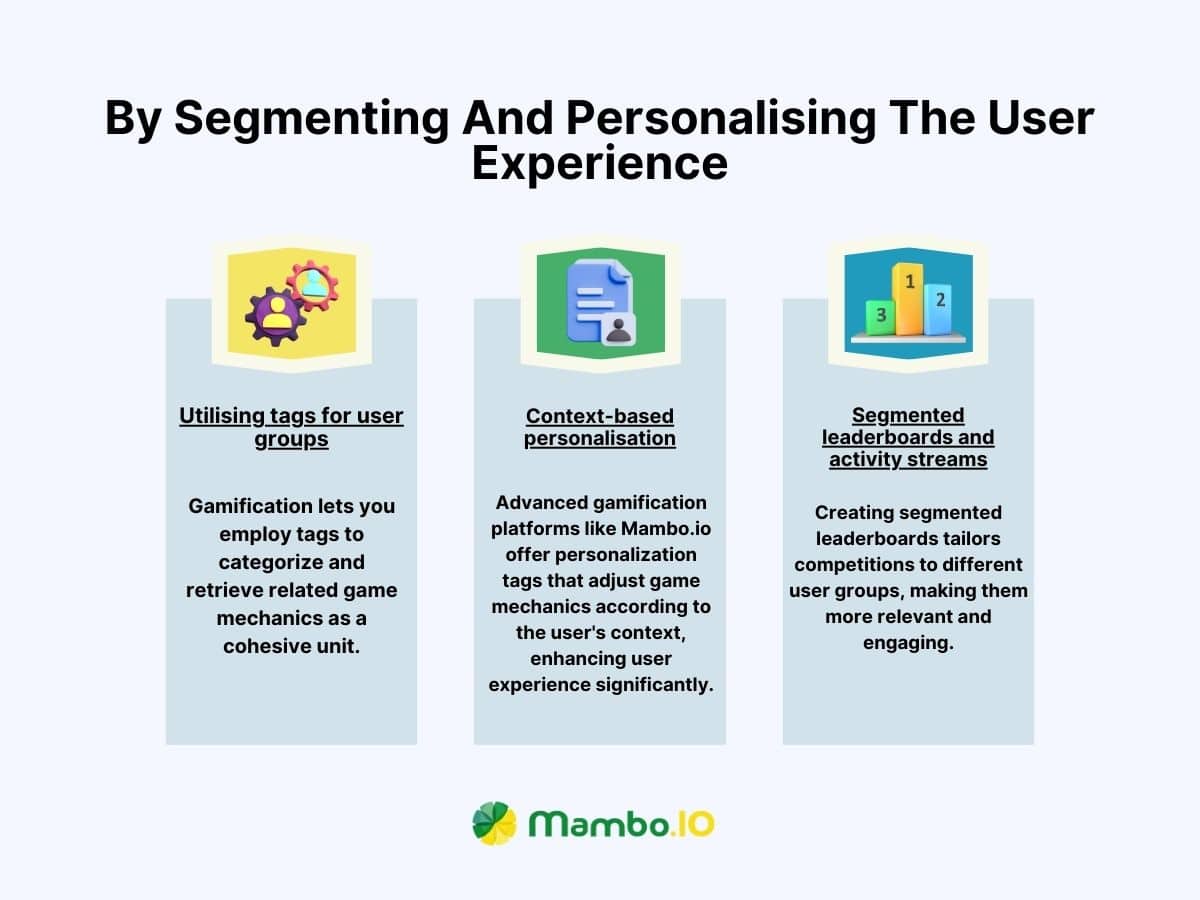
Utilising tags for user groups
Gamification enables you to implement regular tags into your strategy. These tags allow you to cluster related game mechanics and retrieve them as a unit. For example, if your KPI focuses on improving your onboarding experience, you can tag all relevant mechanics under “Onboarding”. This makes managing and measuring these components straightforward, giving you a clearer picture of your KPIs.
Context-based personalisation
Advanced gamification platforms like Mambo.io step things up a notch with personalisation tags. These tags filter game mechanics based on the current user’s context, significantly elevating user experience.
Let’s say you’ve got a divided workforce: an HR department and a sales department. If so, you can use personalisation tags to ensure each department can access relevant gamified experiences. This ensures that your gamification metrics and KPIs are more targeted and impactful.
Segmented leaderboards and activity streams
You can also extend tags to your leaderboards and activity streams. Creating a segmented leaderboard can make competitions more relevant and motivating for different user groups. For example, a leaderboard for the sales team might focus on metrics like client engagement and deals closed. The HR team, on the other hand, could be based on metrics like employee management or training completion rates.
By fostering healthy competition
Competition has always been one of humanity’s greatest driving forces, and it’s present in various fields like business and sports. And in gamification, the power of competition is amplified many times over.
Contests can drive performance and generate metrics, whether it’s a competition to achieve a goal or to solve a challenge. Moreover, companies use gamified scoring systems to track participant progress and award prizes to the winners.
Here’s how fostering healthy competition can supercharge your gamification metrics and KPIs.
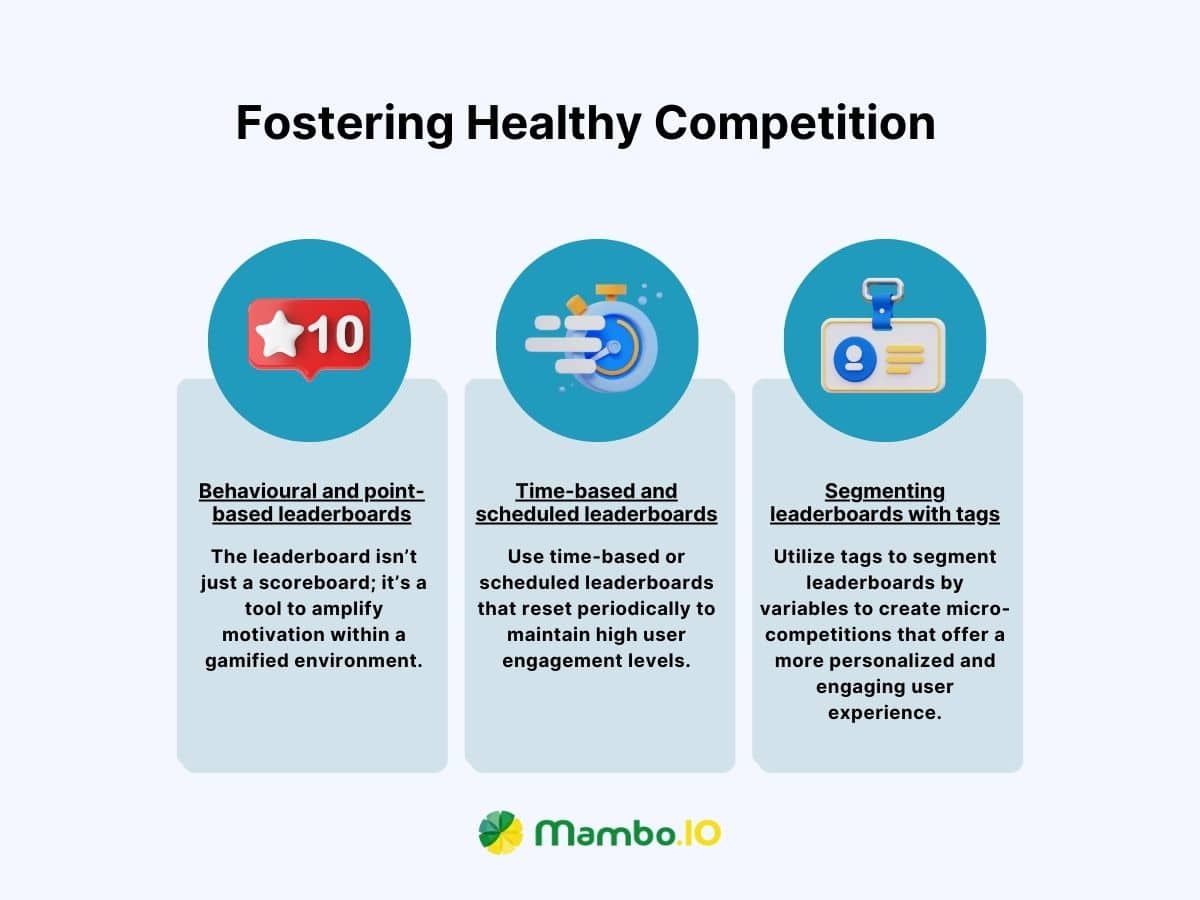
Behavioural and point-based leaderboards
The cornerstone of inducing competition in a gamified setting is the leaderboard. Now, don’t think of it as just a “scoreboard”; picture it as a motivational multiplier.
You can set up behavioural and point-based leaderboards to rank users according to specific actions or point accumulations. You can even combine the two!
Let’s say your KPI is to enhance customer engagement. If so, your leaderboard could reward points for leaving reviews, sharing points, or marking referrals.
Time-based and scheduled leaderboards
It’s essential to keep your users’ energy levels high. To do this, you can introduce time-based or scheduled leaderboards that reset daily, weekly, or monthly.
This approach ensures two things:
- It gives everyone a fair shot at climbing to the top.
- It adds a sense of urgency and purpose, maximising engagement and positively affecting your KPIs.
Segmenting leaderboards with tags
Gamification can go the extra mile by partitioning leaderboards with tags based on many variables like department, team, and role. Doing so lets you create micro-competitions within the broader context, offering users a more personalised and engaging experience.
For example, you can have a leaderboard for “Best Sales in London” and another for “Most Active User in Marketing”. Such granular segmentation lets you get extremely specific with your gamification metrics and KPIs. More importantly, it enables you to customise your KPIs according to your organisation’s needs and objectives.
Gamification is a powerful tool that can transform your KPIs from mundane metrics into exciting challenges. But before you proceed with gamifying KPIs, you’ll need to ponder some considerations first.
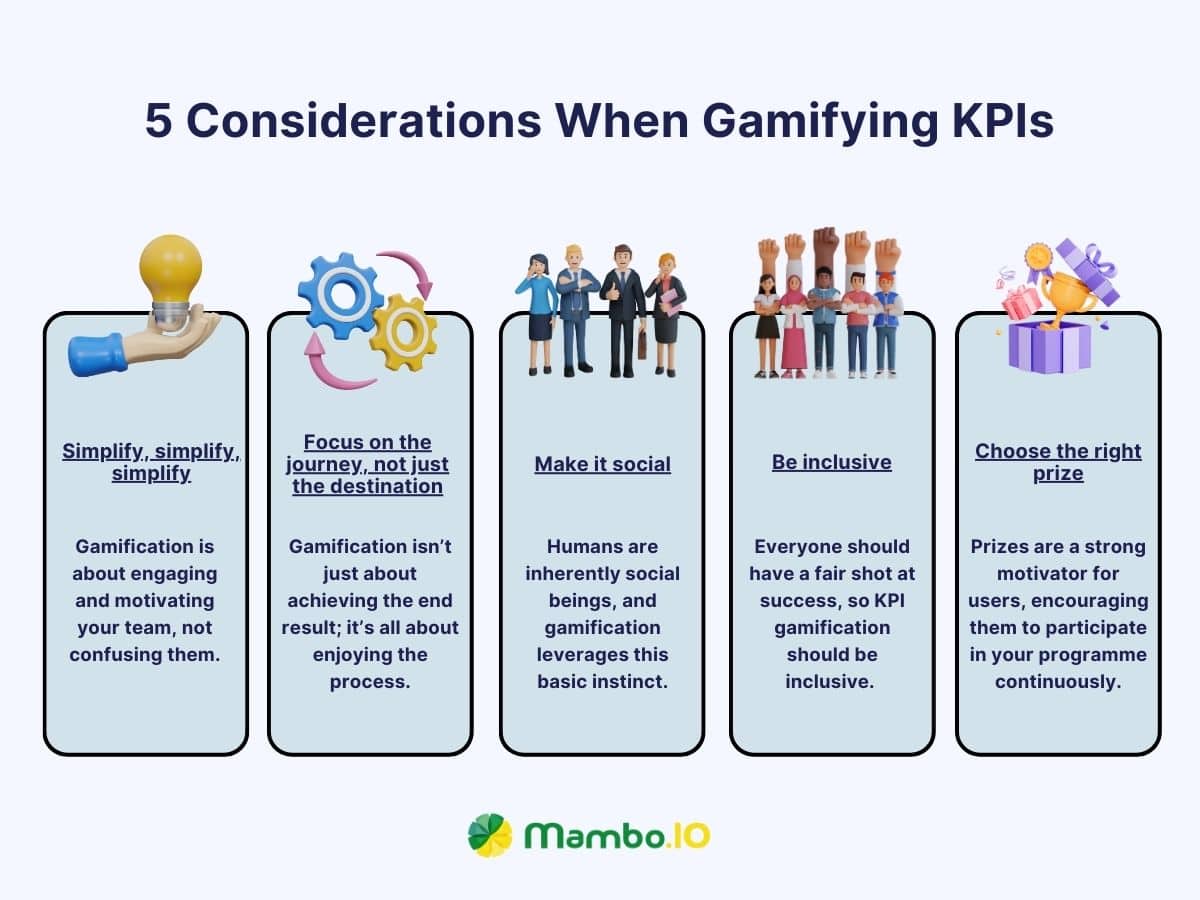
#1. Simplify, simplify, simplify
Simplicity is vital when it comes to gamifying KPIs. Your KPIs should be crystal clear and with no room for ambiguity.
Gamification is about engaging and motivating your team, not confusing them. More importantly, your strategy must be clear and straightforward to make things easier for your team. Making it overcomplicated will frustrate users, which will ultimately lead to disengagement.
Remember that complexity can quickly drain the fun out of the game.
#2. Focus on the journey, not just the destination
Gamification isn’t just about achieving the end result; it’s all about enjoying the process. So, when gamifying KPIs, your goal should be to continually enhance the user experience.
To achieve this, you must design your strategy to enable users to track their progress and witness their ongoing improvement. Emphasise the journey, create milestones, and celebrate small wins.
With this approach, you can keep users motivated and engaged throughout the journey. This is a much better alternative than focusing on forcing them to do KPI-relevant actions.
Remember, it’s not just about reaching the KPI; it’s about how you get there.
#3. Make it social
Humans are inherently social beings, and gamification leverages this basic instinct because games are more enjoyable when played with friends. With this in mind, encourage collaboration and friendly competition among users.
Create leaderboards where individuals or teams can see how they measure up against their colleagues. Social recognition and a sense of community can be powerful motivators. Integrating this will enhance the fun factor, but it will also foster interactions and cohesion.
#4. Be inclusive
Everyone should have a fair shot at success, so KPI gamification should be inclusive. Don’t exclude anyone from participating; don’t create a game where only a select few can win. Avoid situations where only a few benefits, as this can breed resentment among your users. Moreover, your gamified KPIs are accessible to all team members, and everyone can attain rewards.
#5. Choose the right prize
Prizes are a strong motivator for users, encouraging them to participate in your programme continuously. Because of this, the rewards you choose are critical. It should be something that genuinely motivates your users.
Currency-based incentives are popular but may not be the best fit for every situation. Consider other rewards like exclusive content, XP points, or even coupons. Additionally, always tailor the prize to match your user’s preferences and aspirations.
Incorporating these considerations into your gamification strategy can significantly enhance your KPIs and drive impressive results. Remember, gamification is not a one-size-fits-all solution; it requires thoughtful planning and continuous assessment. Keep these principles close, and your journey into gamifying KPIs will reward you and your organisation.